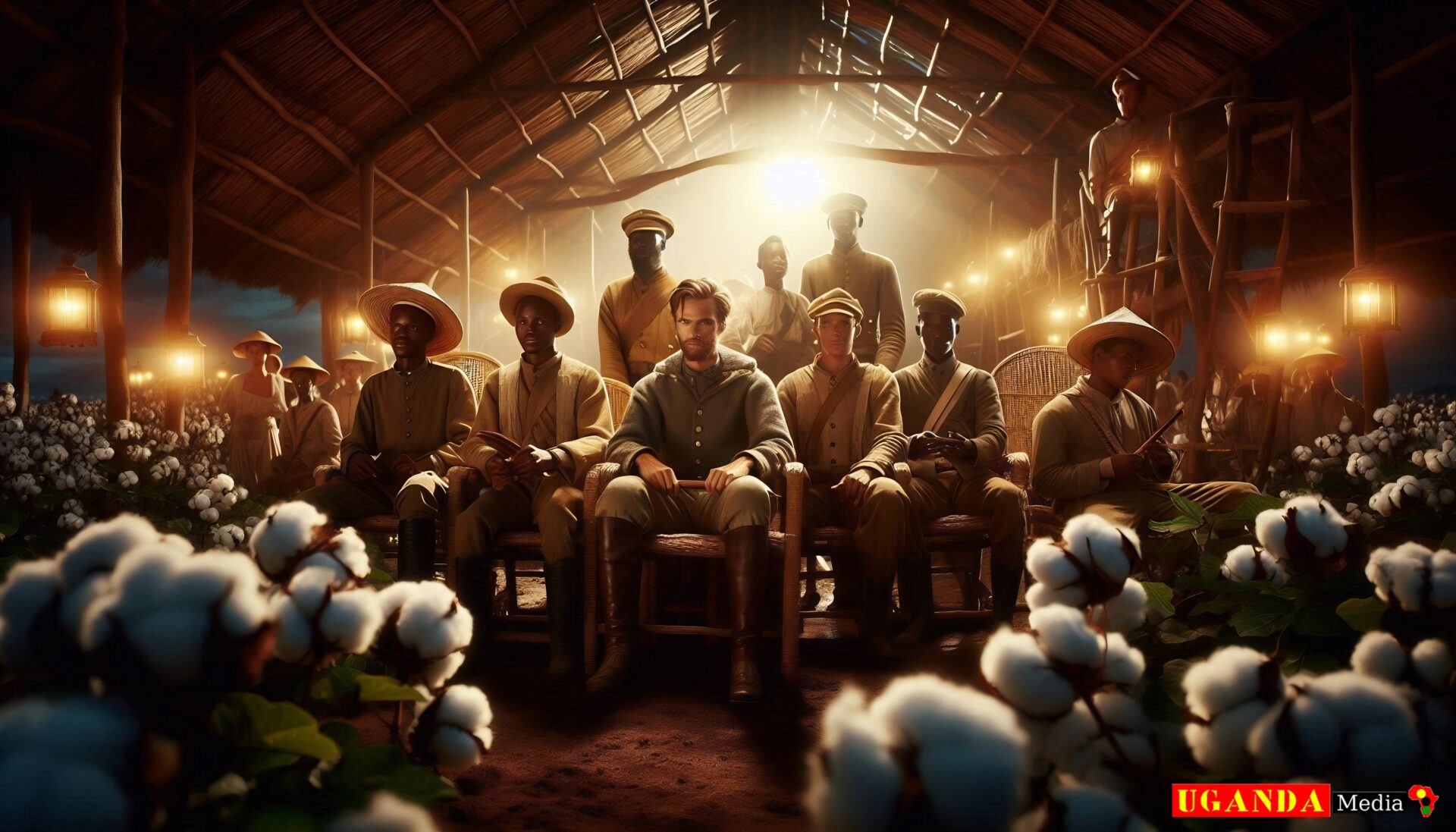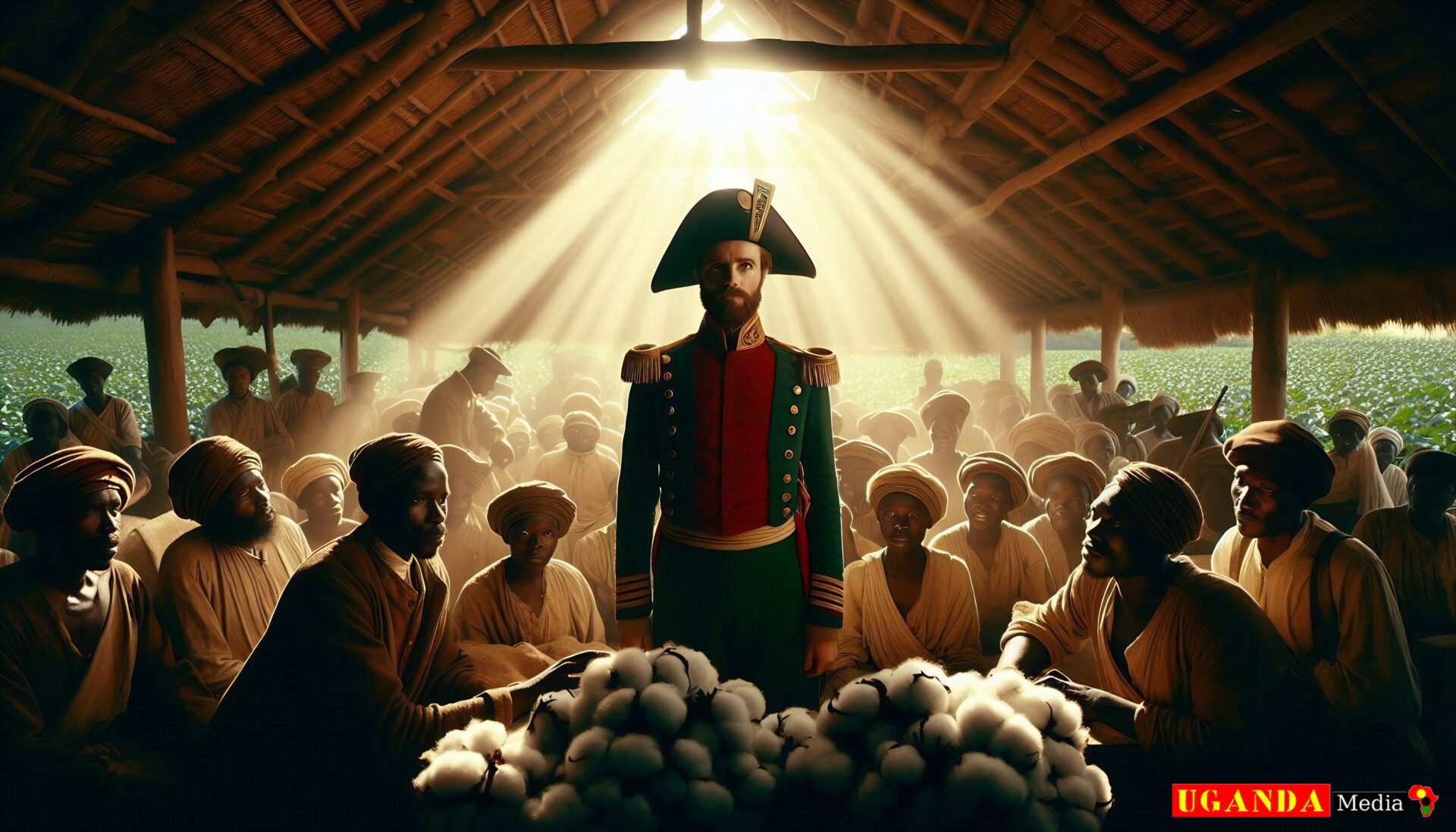The History and Legacy of Commercial Cotton Growing in Busoga District, Uganda (1905–1923)
The story of commercial cotton growing in Busoga District, Uganda, between 1905 and 1923 is a fascinating tapestry of ambition, innovation, and resilience. This era marked the rise of an agricultural revolution driven by African growers, Indian traders, and colonial administrators, whose interactions shaped the economic and social fabric of the region. From the drumbeats echoing through Kamuli in 1911 to the bustling ginneries of Jinja, the period highlights both the triumphs and challenges of Uganda’s early cotton industry.
Key figures like Nanjibhai K. Mehta and Muljibhai P. Madvani , alongside educated chiefs such as Yosia Madiope and Ezekieri Wako , played pivotal roles in transforming Busoga into a hub of cotton production and industrial growth. However, this progress was not without contention. Discriminatory policies like the Five-Mile Radius Rule and the formation of European syndicates marginalised Indian entrepreneurs and African peasants, creating enduring legacies of inequality.

This article delves into the intricate dynamics of seed selection, soil preparation, pest management, and post-harvest practices that maximised cotton yields while addressing the socio-economic implications of monopolistic practices and restrictive legislation. By exploring these historical threads, we uncover valuable lessons on sustainable agriculture, equitable trade, and inclusive governance that remain relevant for contemporary debates around land use, labour rights, and fair trade in Uganda and beyond.
Introduction to Cotton Cultivation
The Fertile Soils and Favourable Climate of Busoga District
Nestled in eastern Uganda, Busoga District is a land of verdant beauty, blessed with fertile soils and a climate that seems almost tailor-made for agriculture. This region, crisscrossed by the mighty River Nile and dotted with lush marshlands, became the heartland of commercial cotton farming during the early 20th century. Its unique combination of natural resources made it an ideal location for cultivating this cash crop, which would eventually transform both the local economy and its social fabric.
Fertile Soils: A Farmer’s Dream
The soils of Busoga are predominantly black loams, renowned for their richness and ability to retain moisture—a characteristic particularly beneficial for crops like cotton. These deep, well-drained soils provided the perfect foundation for root development and sustained growth throughout the growing season. In addition to the black loams, other soil types across the district were equally capable of supporting robust cotton yields, provided they were properly managed through cultivation techniques such as ploughing and weeding.

For instance, areas near the riverbanks boasted alluvial deposits enriched by centuries of sedimentation, creating pockets of exceptionally productive farmland. Farmers working these lands often remarked on how effortlessly cotton plants thrived, producing bolls of remarkable size and quality. Such conditions gave rise to optimism among colonial administrators and local chiefs alike, who saw immense potential in harnessing Busoga’s agricultural promise.
A Favourable Climate: Sunshine and Rainfall in Harmony
In addition to its fertile soils, Busoga enjoys a tropical climate marked by distinct wet and dry seasons—an arrangement that proved highly conducive to cotton cultivation. The rainy season, typically spanning from March to May and again from September to November, ensured consistent moisture levels necessary for germination and early plant growth. Meanwhile, the dry spells between these periods allowed farmers to carry out essential tasks such as picking and drying the harvested cotton without fear of spoilage due to excessive rainfall.
Temperature variations within the district further enhanced its suitability for cotton farming. While some higher-altitude regions in Uganda struggled with cooler temperatures unsuitable for ripening cotton bolls, Busoga’s elevation remained low enough to maintain warmth throughout the year. This consistency in temperature promoted healthy plant development and extended the growing season, giving farmers ample time to nurture their crops.
Challenges Amidst Abundance
Despite these advantages, life as a cotton farmer in Busoga was not without its challenges. Pests and diseases posed significant threats, requiring vigilance and innovative solutions from growers. Moreover, the variability of rainfall patterns meant that timing sowing activities correctly was crucial; planting too early or too late could spell disaster for an entire harvest. To mitigate risks associated with unpredictable weather, agricultural officers introduced practices such as double sowings—a system where farmers planted two separate plots at different times, ensuring at least one would succeed regardless of seasonal fluctuations.
A Landscape Steeped in Tradition
Beyond its physical attributes, Busoga’s landscape carried cultural significance for its people. For generations, communities here had relied on subsistence farming, cultivating staples like matooke (bananas) alongside indigenous crops. Cotton represented a departure from tradition, introducing new rhythms and routines into daily life. Chiefs educated at prestigious institutions like Mengo High School and King’s College, Budo, played pivotal roles in bridging this transition, using their influence to encourage communal efforts and model best practices. Their leadership helped foster a sense of collective responsibility towards embracing cash crop agriculture while honouring age-old customs tied to the land.
Nature’s Bounty Meets Human Ingenuity
Busoga District’s fertile soils and favourable climate formed the bedrock upon which commercial cotton farming flourished during the early decades of the 20th century. Yet, what truly set this region apart was the synergy between nature’s bounty and human ingenuity. From the tireless labour of African cultivators to the entrepreneurial spirit of Indian traders and the strategic oversight of British colonial officials, each group contributed uniquely to shaping Busoga’s destiny. As fields of white cotton stretched across the horizon, they symbolised not just economic opportunity but also resilience, adaptability, and the enduring connection between humanity and the earth.
Colonial Influence: Encouraging Communal Cultivation Near Roadsides Under the Supervision of Educated Chiefs
In the early 20th century, colonial administrators in Uganda devised a strategy to promote commercial cotton cultivation that was both innovative and deeply rooted in their paternalistic approach to governance. This involved encouraging communal cultivation near roadsides, an initiative overseen by educated chiefs who served as intermediaries between the colonial government and local communities. The system was particularly prominent in districts like Busoga, where it became a hallmark of agricultural policy during the period from 1905 to 1923.
The Role of Educated Chiefs
At the heart of this initiative were the educated chiefs—individuals groomed in prestigious institutions such as Mengo High School and King’s College, Budo. These schools, located in Buganda, were designed to produce leaders loyal to colonial ideals while retaining influence within their own communities. For instance, figures like Yosia Madiope, Ezekieri Wako, and Zefania Nabikamba attended these institutions before returning to their districts to implement British policies.
These chiefs were not merely figureheads; they were expected to actively participate in promoting cash crop agriculture. Their education equipped them with administrative skills and an understanding of colonial expectations, making them ideal candidates for supervising communal farming efforts. By working alongside colonial officials, the chiefs helped bridge cultural divides and ensured compliance with directives aimed at transforming subsistence farmers into producers of exportable commodities.
Communal Cultivation Along Roadsides
One of the most striking features of the colonial approach was the emphasis on roadside cultivation. Colonial administrators recognized that poor communication networks posed significant challenges in reaching dispersed rural populations. To address this, they identified sites near major roads as central hubs for communal farming activities. These locations allowed easier access for monitoring progress, distributing instructions, and facilitating the transportation of harvested crops.
Every morning, the scene would unfold with remarkable consistency. Chiefs arrived at the designated roadside fields and announced their presence through traditional drumming, playing rhythms such as SsagaZa agalamidde (“morning sleepers wake up and work”). This ritual not only signalled the start of the day’s labour but also reinforced the authority of the chief over his community. Growers gathered under the watchful eyes of their leaders, receiving guidance on planting techniques, weeding schedules, and pest control measures.
To encourage regular attendance, chiefs often organised social incentives such as beer parties or communal meals. Such gatherings fostered camaraderie among participants and created a sense of collective responsibility towards the success of the project. While seemingly coercive, these practices reflected the broader colonial strategy of blending persuasion with subtle forms of coercion to achieve economic goals.
A Practical Solution Amidst Challenges
From a logistical standpoint, roadside cultivation addressed several practical concerns. First, it mitigated the difficulty of contacting farmers scattered across vast rural landscapes. By concentrating efforts along accessible routes, colonial officials could more easily oversee operations without needing extensive infrastructure. Second, it provided visibility—a visible demonstration of progress that could be showcased to visiting inspectors or higher authorities. Fields brimming with healthy cotton plants served as tangible evidence of successful intervention.
However, the system was not without its flaws. Critics argue that communal cultivation disrupted established patterns of land use and placed undue strain on growers, many of whom had limited experience with cash crops. Additionally, the focus on roadside plots sometimes neglected less accessible areas, leaving some farmers marginalized. Despite these shortcomings, the method proved effective enough to become a cornerstone of early colonial agricultural policy.
Symbolism of Chiefly Leadership
Beyond its practical applications, roadside cultivation carried symbolic weight. Chiefs were required to plant cotton near their residences, setting an example for their subjects. This practice operated on two levels: first, it demonstrated the feasibility—and profitability—of cash crop agriculture, inspiring ordinary “natives” to emulate their leaders. Second, it fostered competition among chiefs themselves, particularly in regions like Busoga, where many administrative roles were occupied by Baganda outsiders vying for favour with British officials.
For example, Kasibante, a regent for Yosia Nadiope of Bugabula, earned commendation from District Commissioner E.M. Isemonger for cultivating expansive fields of high-quality cotton near his headquarters. His meticulous organisation, including dividing fields into small rectangular patches managed by individual households, exemplified the kind of efficiency colonial administrators sought to replicate elsewhere. Such achievements underscored the dual role of chiefs as both enforcers of colonial policies and aspirational models for their communities.
Legacy of Colonial Influence
While the roadside cultivation model succeeded in establishing cotton as a viable cash crop in Busoga and beyond, it also laid bare the complexities of colonial rule. On one hand, it introduced new agricultural techniques and stimulated economic activity. On the other, it entrenched hierarchies and prioritised colonial interests over indigenous needs. The reliance on educated chiefs highlights the paradoxical nature of colonial administration: fostering leadership within African communities while simultaneously controlling and directing it to serve external agendas.
Ultimately, the encouragement of communal cultivation near roadsides under the supervision of educated chiefs represents a pivotal chapter in Uganda’s agricultural history. It reflects the intersection of tradition and modernity, coercion and cooperation, and local agency and imperial ambition—all set against the backdrop of a rapidly changing society striving to adapt to new realities.
The Role of Education: Highlighting the Significance of Institutions Like Mengo and Budo in Grooming Leaders Tasked with Promoting Cash Crops
In the early 20th century, as colonial administrators sought to transform Uganda’s agricultural landscape, they recognised the pivotal role education would play in shaping a new generation of African leaders. Institutions such as Mengo High School and King’s College, Budo—both located in Buganda—emerged as crucibles for grooming individuals who would serve as intermediaries between colonial authorities and local communities. These schools became instrumental in cultivating leaders tasked with promoting cash crops like cotton, particularly in regions like Busoga District where commercial agriculture was being actively encouraged.
Mengo and Budo: Pillars of Colonial-Era Education
Mengo High School, founded in 1906, and King’s College, Budo, established earlier in 1901, were among the premier educational institutions in colonial Uganda. Designed to provide Western-style education, these schools aimed to produce graduates fluent in English, familiar with British customs, and equipped with administrative skills. They were not merely centres of learning but also tools of colonial social engineering, intended to create a class of Africans loyal to British ideals while retaining influence within their own societies.
For example, prominent figures like Yosia Madiope, Ezekieri Wako, and Zefania Nabikamba attended these institutions before assuming leadership roles in Busoga. Their education included exposure to subjects such as history, geography, and rudimentary economics—fields that prepared them to understand and advocate for policies aligned with colonial economic objectives. By immersing students in an environment that emphasised discipline, punctuality, and adherence to authority, these schools instilled values deemed essential for implementing government directives at the grassroots level.
Producing Agents of Change
The primary objective of educating chiefs at Mengo and Budo was to equip them with the knowledge and skills necessary to promote cash crop cultivation effectively. Chiefs were expected to act as agents of change, bridging cultural divides and ensuring compliance with colonial agricultural policies. For instance, after completing his studies at Mengo (1900–1905) and later at Budo (1906–1908), Yosia Madiope returned to Busoga fully prepared to oversee communal cotton farming efforts. Similarly, Ezekieri Wako and Yekonia Lubogo, who studied at Budo during the 1910s, brought back insights into modern agricultural techniques and organisational strategies that proved invaluable in mobilising rural populations.
These educated leaders played a dual role. On one hand, they served as representatives of colonial authority, tasked with enforcing regulations related to land use, labour, and crop production. On the other, they acted as mediators, interpreting and sometimes tempering colonial demands to align with local realities. This unique position allowed them to wield considerable influence over how cash crop initiatives were implemented on the ground.
Promoting Cotton Cultivation Through Educated Leadership
One of the most visible ways in which educated chiefs contributed to promoting cotton cultivation was through their active involvement in roadside communal farming projects. As previously noted, colonial administrators insisted that cotton initially be grown communally near roadsides under the supervision of these leaders. Every morning, chiefs arrived at designated sites, announcing their presence through traditional drumming rhythms like SsagaZa agalamidde (“morning sleepers wake up and work”). This ritual signalled the start of daily labour and reinforced the authority of the chief over his community.
Educated chiefs excelled in organising and motivating growers. For instance, Kasibante—a regent for Yosia Nadiope of Bugabula—earned commendation from District Commissioner E.M. Isemonger for cultivating expansive fields of high-quality cotton near his headquarters. His meticulous organisation, including dividing fields into small rectangular patches managed by individual households, exemplified the kind of efficiency colonial administrators sought to replicate elsewhere. Such achievements underscored the importance of education in equipping leaders with the ability to implement complex agricultural systems successfully.
Moreover, residence-grown cotton served as a powerful tool for inspiring ordinary “natives” to adopt cash crop agriculture. Chiefs were required to plant cotton near their homes, setting an example for their subjects. This practice operated on two levels: first, it demonstrated the feasibility—and profitability—of cash crop agriculture, encouraging ordinary farmers to emulate their leaders; second, it fostered competition among the chiefs themselves, particularly in regions like Busoga, where many administrative roles were occupied by Baganda outsiders vying for favour with British officials.
Challenges and Criticisms
While the contributions of educated chiefs cannot be overstated, this system was not without its challenges. Critics argue that the emphasis on Western-style education created a disconnect between these leaders and their communities. Many ordinary Basoga viewed these educated elites as out of touch with traditional ways of life, leading to tensions and resistance against imposed agricultural practices. Additionally, the competitive nature of the system sometimes exacerbated rivalries among chiefs, diverting focus away from collective progress toward personal advancement.
Furthermore, the paternalistic approach inherent in colonial education meant that chiefs were often trained to prioritise British interests over indigenous needs. While they gained valuable skills and knowledge, they also became enforcers of policies that sometimes disadvantaged their own people. For instance, when open markets were introduced in 1913, ostensibly to protect African growers from unscrupulous Indian traders, the move inadvertently deprived many farmers of opportunities to participate in other aspects of the cotton industry. Educated chiefs found themselves caught between implementing such policies and addressing the grievances of their constituents.
Legacy of Educational Influence
Despite these challenges, the legacy of institutions like Mengo and Budo endures in Uganda’s agricultural history. By producing leaders capable of navigating both colonial and local contexts, these schools laid the foundation for a model of governance that blended tradition with modernity. The emphasis on education as a means of promoting economic development continues to resonate today, serving as a reminder of the enduring impact of human capital investment.
Ultimately, the significance of Mengo and Budo lies not just in the individuals they produced but in the broader societal shifts they facilitated. Through their graduates, these institutions helped usher in an era of transformation, where cash crops like cotton became central to Uganda’s economy and identity. Yet, they also highlight the complexities of colonial rule, revealing how education could simultaneously empower and constrain those it sought to uplift.
Chiefs as Role Models: How Residence-Grown Cotton Served as a Model for Ordinary “Natives” to Adopt Cash Crop Agriculture
In the early 20th century, one of the most effective strategies employed by colonial administrators in Uganda to promote cash crop agriculture—particularly cotton cultivation—was the requirement for chiefs to grow cotton near their residences. This initiative, implemented across regions like Busoga District, was designed not only to demonstrate the feasibility and profitability of cash crops but also to inspire ordinary “natives” to follow suit. By positioning chiefs as role models, colonial authorities sought to bridge cultural divides and encourage the widespread adoption of commercial farming practices. The success of this approach rested on the dual objectives of impressing local communities and fostering healthy competition among leaders.
A Visible Demonstration of Feasibility
Residence-grown cotton served as a tangible example of how cash crops could be successfully integrated into traditional agricultural systems. Chiefs, who were often educated at prestigious institutions such as Mengo High School or King’s College, Budo, were expected to lead by example. Their proximity to colonial ideals and modern agricultural techniques made them uniquely positioned to experiment with and showcase the benefits of cotton cultivation.
For instance, Kasibante—a regent for Yosia Nadiope of Bugabula—cultivated approximately 50 acres of high-quality cotton near his headquarters. His fields were meticulously organized into small rectangular patches assigned to individual households, each overseen by designated supervisors to ensure optimal maintenance. When District Commissioner E.M. Isemonger visited these fields, he praised them as “the best kept and healthiest field I have seen in the country,” predicting a bountiful harvest. Such visible successes demonstrated that cotton could thrive under proper management, providing a compelling argument for ordinary farmers to emulate their leaders.
The presence of thriving cotton plots near chief’s residences acted as a constant reminder of its potential. Every morning, as chiefs arrived at communal roadside sites to oversee collective efforts, they brought with them stories of progress from their own lands. These narratives reinforced the idea that adopting cash crop agriculture was not only possible but advantageous. For many Basoga farmers accustomed to subsistence farming, seeing their leaders achieve tangible results helped demystify the transition to commercial agriculture.
Fostering Competition Among Chiefs
Beyond inspiring ordinary growers, residence-grown cotton also encouraged rivalry among chiefs themselves. In Busoga, where administrative roles between 1900 and 1915 were largely occupied by Baganda outsiders competing for favour with British officials, cultivating impressive cotton fields became a means of asserting authority and securing promotions. Chiefs understood that their performance in promoting cash crops directly influenced their standing within the colonial hierarchy.
Kasibante’s commendation by District Commissioner Isemonger is a case in point. His dedication to producing fine cotton earned him recognition and likely bolstered his reputation among both colonial superiors and local constituents. Similarly, other prominent figures like Yosia Madiope, Ezekieri Wako, and Zefania Nabikamba leveraged their education and administrative skills to excel in cotton cultivation, further solidifying their positions as influential leaders.
This competitive dynamic had cascading effects on ordinary “natives.” As chiefs vied to outperform one another, they invested more resources and effort into demonstrating the viability of cash crops. Consequently, their subjects benefited from improved knowledge sharing, better access to quality seeds, and enhanced organizational structures—all of which facilitated smoother transitions to cash crop agriculture.
Inspiring Confidence Through Leadership
The principle of “follow my leader” underpinned much of the colonial strategy. Chiefs were not merely figureheads; they embodied the values and practices colonial administrators wished to instil in rural populations. By planting cotton near their homes, they provided a relatable model for ordinary Basoga farmers. Seeing respected community leaders engage in cash crop cultivation reassured growers that embracing new agricultural methods would not alienate them from their traditions, but rather enhance their livelihoods.
Moreover, residence-grown cotton allowed chiefs to address practical concerns firsthand. They could identify challenges related to soil preparation, pest control, or harvesting and devise solutions tailored to local conditions. This hands-on experience enabled them to offer informed guidance to their subjects, fostering trust and cooperation. Chiefs’ ability to balance innovation with tradition proved instrumental in overcoming resistance to change.
Challenges and Criticisms
While residence-grown cotton achieved significant successes, it was not without its drawbacks. Critics argue that the emphasis on chiefs as role models sometimes created unrealistic expectations. Many ordinary Basoga farmers lacked the resources, expertise, or support networks available to their leaders, making it difficult to replicate similar outcomes. Additionally, the competitive nature of the system occasionally exacerbated tensions among chiefs, diverting focus away from collective progress toward personal advancement.
Furthermore, some viewed the requirement for chiefs to cultivate cotton near their residences as coercive. While intended to inspire confidence, it could also be perceived as an imposition, undermining the very trust colonial authorities sought to build. Despite these challenges, however, the overall impact of residence-grown cotton cannot be overstated. It laid the groundwork for broader acceptance of cash crop agriculture and contributed significantly to the economic transformation of regions like Busoga.
Legacy of Chiefs as Agricultural Pioneers
The legacy of residence-grown cotton extends far beyond the early 20th century. By positioning chiefs as pioneers in cash crop agriculture, colonial administrators inadvertently empowered a generation of leaders capable of navigating both traditional and modern contexts. Their contributions helped establish cotton as a cornerstone of Uganda’s economy, shaping policies and practices that continue to influence agricultural development today.
Ultimately, residence-grown cotton exemplifies the intersection of leadership, innovation, and resilience. Through their fields, chiefs communicated a powerful message: that embracing cash crop agriculture offered opportunities for growth and prosperity. Whether through Kasibante’s meticulously managed plots or Yosia Madiope’s commitment to communal farming, these leaders left an indelible mark on Uganda’s agricultural history—a testament to the enduring power of role models in driving societal change.
Indian Traders and Their Impact
Pioneering Efforts: How Indian Merchants Ventured Deep into Rural Uganda Despite Risks from Disease, Lack of Infrastructure, and Cultural Barriers
The story of Indian merchants in Uganda during the early 20th century is one of remarkable resilience, entrepreneurial spirit, and unwavering determination. These pioneers ventured deep into rural areas—often far removed from established towns or colonial outposts—to establish trade networks that would transform the country’s economy. Their efforts were particularly evident in the cotton industry, where they played a pivotal role in stimulating production, connecting African growers to global markets, and laying the groundwork for industrial growth. Yet, their journey was fraught with significant challenges, including widespread disease, inadequate infrastructure, and profound cultural barriers.
Venturing Into the Unknown
Indian merchants, many of whom hailed from Gujarat in western India, arrived in Uganda as immigrants seeking economic opportunities. They were drawn by the promise of untapped potential in East Africa’s burgeoning agricultural sector. Cotton, which had been introduced as a cash crop in the early 1900s, became a focal point of their enterprise. However, reaching the source of this valuable commodity required venturing into some of the most remote and inhospitable regions of Uganda.
In districts like Busoga, Teso, and Lango, Indian traders travelled on foot, by bicycle, or occasionally by rudimentary carts to reach scattered homesteads where African farmers cultivated cotton. The terrain they traversed was often rugged and marshy, making travel arduous and time-consuming. For example, the dense forests and swamps surrounding Lake Kyoga posed formidable obstacles, while the savannas of eastern Uganda offered little shelter from harsh weather conditions. Despite these difficulties, Indian merchants persisted, driven by the prospect of securing raw materials at competitive prices.
Their willingness to go “deep into the countryside” set them apart from European traders, who largely confined themselves to urban centres or relied on intermediaries. This hands-on approach allowed Indians to build direct relationships with African growers, fostering trust and ensuring a steady supply of high-quality cotton. As noted in historical accounts, Indian merchants were described as “entrepreneurs beyond comparison,” whose ventures shortened distances growers had to walk to sell their produce and reduced exposure risks for harvested cotton.
Facing Health Risks
One of the gravest dangers faced by Indian merchants was the prevalence of tropical diseases such as malaria, sleeping sickness, and dysentery. Medical facilities in rural Uganda were virtually nonexistent during the early 20th century, leaving traders vulnerable to illness without recourse to proper treatment. Malaria, transmitted through mosquito bites, was especially rampant in low-lying areas near rivers and lakes, including parts of Busoga District. Many Indian merchants fell victim to these diseases, yet their determination remained unshaken.
For instance, Nanjibhai K. Mehta, who started as a simple shopkeeper in Kamuli, experimented with cotton cultivation in the backyards of his store before expanding into buying and ginning operations. His success came not only from business acumen but also from enduring the physical toll of working in challenging environments. Similarly, Muljibhai P. Madvani, another prominent figure in Uganda’s economic history, overcame health risks and logistical hurdles to establish himself as a leading entrepreneur in the cotton trade.
These individuals exemplified the courage and tenacity required to thrive in an environment where even basic necessities like clean water and sanitation were scarce. Their ability to adapt to local conditions and persevere despite health threats underscores their pioneering spirit.
Navigating Infrastructure Deficits
Beyond health risks, Indian merchants contended with severe deficiencies in infrastructure. Roads were either non-existent or poorly maintained, isolating rural communities from major trading hubs. Transportation of goods, whether it involved moving bales of cotton to ginneries or delivering supplies to farmers, was a labour-intensive process that tested the limits of human endurance.
To overcome these limitations, Indian traders innovated. They established ginneries closer to growing regions, thereby reducing the distance farmers needed to transport their harvests. Alidina Visram, for example, erected ginneries at Jinja in 1911/12, strategically positioning them to serve nearby districts. This initiative not only streamlined operations but also created employment opportunities for locals, further integrating Indian enterprises into the fabric of Ugandan society.
However, the lack of police protection added another layer of complexity. Merchants operating in remote areas frequently encountered banditry and theft, forcing them to rely on personal vigilance or informal agreements with local leaders for safety. In some cases, traders armed themselves or hired escorts to safeguard their journeys—a testament to the lengths they were willing to go to protect their investments.
Overcoming Cultural Barriers
Perhaps the most daunting challenge faced by Indian merchants was navigating cultural barriers. Upon arriving in Uganda, many found themselves in unfamiliar social landscapes characterized by diverse languages, customs, and traditions. Establishing rapport with African communities required patience, diplomacy, and a genuine understanding of local values.
Initially, interactions between Indian traders and African growers were marked by mutual curiosity and cautious cooperation. Over time, however, shared economic interests fostered stronger bonds. Indian merchants learned local dialects, participated in community gatherings, and adapted their business practices to align with indigenous norms. For example, offering small gifts or hosting meals became common strategies for building goodwill among farmers.
Despite these efforts, tensions occasionally arose due to misunderstandings or perceived exploitation. Critics accused some Indian traders of paying unfairly low prices for cotton or charging exorbitant fees for ginning services. While such allegations were not universal, they highlight the delicate balance Indian merchants had to strike between profitability and ethical conduct.
Legacy of Resilience
The pioneering efforts of Indian merchants left an indelible mark on Uganda’s economic landscape. By venturing into rural areas, they bridged gaps in the supply chain, stimulated cotton production, and contributed to the rise of industries such as sugar manufacturing. Figures like Nanjibhai Mehta and Muljibhai Madvani epitomized the transformative power of entrepreneurship, leveraging their experiences in the cotton trade to diversify into other sectors.
Moreover, their contributions extended beyond economics. Indian merchants helped introduce new technologies, fostered cross-cultural exchanges, and laid the foundation for future generations of entrepreneurs. Their legacy serves as a reminder of the extraordinary achievements possible when determination meets opportunity—even in the face of seemingly insurmountable odds.
In conclusion, the story of Indian merchants in rural Uganda is one of grit, innovation, and perseverance. Their willingness to confront disease, navigate infrastructure deficits, and overcome cultural barriers underscores their pivotal role in shaping the nation’s agricultural and industrial development. Through their endeavours, they enriched themselves and contributed to the broader narrative of Uganda’s progress during a transformative era.
Economic Contributions: How Indians Stimulated Cotton Production Through Ginneries and Middleman Activities
The economic contributions of Indian merchants to the development of Uganda’s cotton industry during the early 20th century are both profound and multifaceted. Through their establishment of ginneries and their role as middlemen, Indians played a pivotal role in stimulating cotton production, connecting African growers to global markets, and laying the groundwork for industrial growth. Their efforts transformed the agricultural landscape and reshaped the socio-economic fabric of regions like Busoga District, where cotton became a cornerstone of local economies.
Establishing Ginneries: A Catalyst for Growth
One of the most significant ways in which Indian merchants stimulated cotton production was through the construction of ginneries—facilities designed to separate cotton fibres from seeds. Prior to the introduction of these facilities, African farmers faced immense challenges in processing their harvests. Cotton bolls, once picked, comprised roughly two-thirds seeds—an unmarketable waste product at the time. Without access to efficient ginning technology, farmers were forced to transport raw cotton over long distances to sell it, exposing their produce to damage and reducing its market value.
Indian entrepreneurs recognized this gap in the supply chain and moved swiftly to address it. For example, Alidina Visram, a prominent trader, established ginneries in Jinja as early as 1911–1912. These strategically located facilities shortened the distance growers had to travel to sell their cotton, thereby encouraging increased participation in the cash crop economy. Similarly, Nanjibhai K. Mehta, who began as a simple shopkeeper in Kamuli, expanded his operations to include ginneries in Kamuli and Busembatia after amassing substantial profits from cotton trading during World War I. His ventures facilitated cotton processing and provided employment opportunities for locals, further integrating Indian enterprises into Ugandan society.
By erecting ginneries closer to growing regions, Indian merchants effectively reduced logistical barriers for African farmers. This proximity allowed growers to reduce the time during which their cotton remained exposed to environmental risks such as rain or pests. Moreover, the presence of multiple ginneries fostered healthy competition among buyers, driving up prices even during periods when global demand fluctuated. As a result, Indian-owned ginneries became a familiar feature across Uganda, with nearly 90% of the country’s ginning capacity controlled by Indians by the mid-1920s.
Middleman Activities: Bridging Growers and Markets
In addition to operating ginneries, Indian merchants served as indispensable intermediaries between African growers and international markets. Known locally as “middlemen,” they bought raw cotton directly from farmers, often venturing deep into rural areas despite formidable risks such as disease, lack of police protection, and challenging terrain. Their willingness to penetrate remote regions ensured that no grower was left without access to a buyer, thereby bolstering overall production levels.
The role of middlemen extended beyond mere purchasing. They introduced innovative practices that streamlined the marketing process, making it easier for farmers to participate in the broader economy. For instance, the double sowing system adopted in Teso district—a method where each cultivator maintained two plots sown at different times—was likely influenced by interactions with Indian traders. By ensuring that at least one plot adapted to seasonal variability, this approach minimized the risk of total crop failure and maximised yields.
Furthermore, Indian middlemen helped popularise Ugandan cotton on the global stage. Beginning in 1914, they successfully introduced Uganda cotton to Indian mills, highlighting its suitability for spinning finer fibres. The subsequent rise in exports to Bombay created a virtuous cycle: increased demand from India incentivised higher production in Uganda, while improved transportation networks facilitated smoother trade flows. Japan, too, emerged as a ready buyer of surplus cotton from the Bombay market, underscoring the far-reaching impact of Indian entrepreneurial efforts.
Economic Prosperity and Social Transformation
The economic contributions of Indian merchants were not confined to infrastructure and trade alone; they also catalysed broader social transformations within Ugandan communities. As cotton cultivation gained traction, many African households experienced unprecedented prosperity. Evidence of this newfound wealth surfaced during the 1920s, with reports indicating that some growers could afford luxuries previously unimaginable. Chiefs’ salaries and pensions, for example, saw significant increases due to heightened productivity in their domains.
Indian merchants themselves reaped considerable rewards from their involvement in the cotton trade. Figures like Muljibhai P. Madvani leveraged their profits to diversify into other sectors, establishing sugar estates at Kakira during the 1920s. Likewise, Nanjibhai Mehta’s success in cotton enabled him to build the Lugazi sugar works in 1923, marking the beginning of Uganda’s modern agro-industrial sector. These achievements underscored the transformative power of entrepreneurship, demonstrating how individual initiative could drive collective progress.
Challenges and Criticisms
Despite their undeniable contributions, Indian merchants faced criticism from various quarters. Some accused them of exploiting African growers by paying unfairly low prices for raw cotton and charging exorbitant fees for ginning services. While such allegations were not universal, they highlighted the delicate balance Indian traders had to strike between profitability and ethical conduct. Additionally, the British colonial government viewed Indian dominance in the cotton trade with suspicion, fearing that it undermined Lancashire’s interests by diverting high-quality fibres to Indian mills.
To counteract this perceived threat, the colonial administration implemented restrictive measures such as the Uganda Cotton Rules of 1918 and the Five-Mile Radius Policy of 1919. These regulations severely curtailed Indian activities, granting artificial protection to smaller European-owned ginneries in interior districts while cutting off supplies to larger Indian-owned facilities at ports like Jinja and Kampala. Despite these obstacles, however, Indian merchants continued to innovate and adapt, maintaining their influence over the industry well into the interwar period.
Legacy of Economic Contributions
The legacy of Indian merchants in Uganda’s cotton industry is one of resilience, ingenuity, and enduring impact. By establishing ginneries and serving as middlemen, they bridged critical gaps in the supply chain, stimulated production, and connected African growers to global markets. Their efforts laid the foundation for future generations of entrepreneurs and contributed significantly to Uganda’s economic development.
Ultimately, the story of Indian contributions to cotton production serves as a testament to the extraordinary achievements possible when determination meets opportunity—even in the face of seemingly insurmountable odds. Through their endeavours, Indian merchants not only enriched themselves but also enriched the nation, leaving an indelible mark on Uganda’s history.
Success Stories: Profiling Entrepreneurs Like Nanjibhai K. Mehta and Muljibhai P. Madvani, Whose Ventures Laid Foundations for Future Industries
The story of commercial cotton growing in Uganda during the early 20th century is incomplete without highlighting the remarkable achievements of pioneering entrepreneurs such as Nanjibhai K. Mehta and Muljibhai P. Madvani. These individuals not only rose to prominence through their involvement in the cotton trade but also leveraged their successes to establish industries that would shape Uganda’s economic landscape for decades to come. Their journeys exemplify resilience, vision, and an unwavering commitment to progress—qualities that continue to inspire generations.
Nanjibhai K. Mehta: From Humble Beginnings to Industrial Magnate
Nanjibhai K. Mehta’s journey began in Kamuli, a bustling town in Busoga District, where he initially operated a modest shop catering to local needs. However, his entrepreneurial spirit soon led him to experiment with cotton cultivation in the backyards of his shop. This venture proved so successful that it marked the beginning of a transformative odyssey into the heart of Uganda’s agricultural economy.
During World War I, Mehta capitalized on the global demand for cotton by purchasing raw cotton directly from African growers at competitive prices. His timing was impeccable; shipping disruptions severely impacted Britain’s ability to transport goods between its colonies, creating opportunities for Indian merchants with direct access to East Africa. By the war’s end, Mehta had amassed substantial wealth, enabling him to expand his operations significantly.
In 1918, he erected ginneries in Kamuli and Busembatia, strategically positioning them near key growing regions. These facilities streamlined the processing of cotton and provided employment opportunities for locals, further integrating his enterprises into Ugandan society. The profits generated from these ventures laid the groundwork for even more ambitious projects. In 1923, Mehta founded the Lugazi Sugar Works, marking the dawn of modern agro-industrial development in Uganda.
Mehta’s success was not merely a personal triumph; it represented a broader shift towards industrialization in the region. His ability to identify gaps in the supply chain—from cultivation to processing—and address them effectively demonstrated his acute business acumen. Moreover, his investments in infrastructure, such as roads and storage facilities, facilitated smoother trade flows, benefiting both growers and other stakeholders.
Reflecting on his life in Dream Half Expressed (1966), Mehta recounted how his early struggles shaped his approach to entrepreneurship. He emphasized the importance of perseverance, adaptability, and ethical conduct in building sustainable businesses. Through his efforts, he enriched himself and contributed to the economic empowerment of countless Ugandans.
Muljibhai P. Madvani: A Visionary Leader in Agribusiness
Another towering figure in Uganda’s economic history is Muljibhai P. Madvani, whose contributions to the cotton industry paved the way for the establishment of one of the country’s largest sugar estates. Like Mehta, Madvani hailed from Gujarat and arrived in Uganda seeking opportunities. Initially managing Vitaldas Haridas and Company at Iganga, he quickly distinguished himself as a shrewd trader with a keen eye for innovation.
Madvani’s breakthrough came during the First World War when he, too, capitalized on the surge in demand for Ugandan cotton. His meticulous approach to buying and marketing earned him a reputation for fairness and reliability among African growers. As his profits grew, so did his ambitions. During the 1920s, Madvani invested heavily in the construction of ginneries, ensuring that growers had convenient access to processing facilities. This move enhanced efficiency and strengthened his ties with local communities.
However, Madvani’s most enduring legacy lies in his decision to diversify into sugar production. Recognizing the potential of sugarcane cultivation in eastern Uganda, he established a sprawling estate at Kakira during the 1920s. This venture transformed Kakira into a hub of agricultural and industrial activity, generating thousands of jobs and stimulating ancillary industries such as transportation and manufacturing.
Madvani’s leadership style was characterized by pragmatism and foresight. He understood the importance of aligning his interests with those of the communities in which he operated. For instance, he introduced welfare programs for workers, including healthcare and education initiatives, fostering loyalty and goodwill. His emphasis on corporate social responsibility set a precedent for future entrepreneurs, demonstrating that profitability and social impact could coexist harmoniously.
Foundations for Future Industries
The contributions of Mehta and Madvani extended far beyond their immediate successes in the cotton trade. Both men played pivotal roles in laying the foundations for Uganda’s industrial sector, particularly in agriculture-based manufacturing. Their investments in ginneries, sugar estates, and related infrastructure created ecosystems that supported diverse economic activities.
For example, the Lugazi Sugar Works established by Mehta became a cornerstone of Uganda’s sugar industry, supplying both domestic and international markets. Similarly, Madvani’s Kakira estate emerged as a model of integrated agribusiness, combining cultivation, processing, and distribution under one umbrella. These ventures not only diversified Uganda’s export portfolio but also reduced dependency on imported goods, bolstering the nation’s self-sufficiency.
Moreover, the ripple effects of their achievements were felt across various sectors. The expansion of cotton ginneries and sugar estates spurred demand for skilled labor, encouraging migration from India and other parts of Uganda. Artisans, engineers, and administrative workers found ample opportunities to contribute their expertise, further enriching the socio-economic fabric of the region.
Challenges and Resilience
Despite their successes, Mehta and Madvani faced significant challenges along the way. Colonial policies, such as the Uganda Cotton Rules of 1918 and the Five-Mile Radius Policy of 1919, sought to curb Indian dominance in the cotton trade by favouring European-owned enterprises. These regulations severely restricted access to supplies and markets, threatening the viability of their operations.
In response, both entrepreneurs adapted strategically. They diversified their portfolios, ventured into new industries, and advocated for fairer treatment through organizations like the Free Traders’ Union of Uganda. Their resilience in the face of adversity serves as a testament to their determination to overcome obstacles and leave a lasting legacy.
Legacy and Inspiration
Today, the legacies of Nanjibhai K. Mehta and Muljibhai P. Madvani endure as symbols of what can be achieved through hard work, innovation, and collaboration. Their stories underscore the transformative power of entrepreneurship, illustrating how individual initiative can drive collective progress. Through their ventures, they built prosperous businesses and contributed to the broader narrative of Uganda’s development during a transformative era.
Ultimately, the success stories of Mehta and Madvani remind us that true leadership transcends profit margins. It involves creating value for society, empowering communities, and leaving behind institutions that stand the test of time. As Uganda continues to navigate its path toward economic growth, the lessons imparted by these pioneers remain as relevant today as they were a century ago.
Cultural Exchange: Analysing How Interactions Between Indians, Africans, and Europeans Created a Unique Socio-economic Dynamic
The interactions between Indians, Africans, and Europeans in colonial Uganda during the early 20th century were not merely transactions of trade or labour; they represented a profound cultural exchange that shaped the socio-economic fabric of the region. These interactions, particularly within the context of the cotton industry, created a unique dynamic marked by collaboration, tension, adaptation, and mutual influence. This dynamic was especially evident in districts like Busoga, where the convergence of these three groups played a pivotal role in transforming traditional agricultural practices into a modern cash crop economy.
A Tripartite Relationship in the Cotton Economy
At the heart of this cultural exchange lay the cotton industry—a sector dominated by Indian merchants, cultivated by African farmers, and regulated by European colonial administrators. Each group brought distinct perspectives, skills, and motivations to the table, resulting in a complex interplay of interests.
- Indian Merchants as Economic Catalysts
Indian traders emerged as key intermediaries in the cotton supply chain, bridging the gap between African growers and global markets. Their willingness to venture deep into rural areas—despite risks such as disease, lack of infrastructure, and cultural barriers—demonstrated an entrepreneurial spirit that left an indelible mark on Ugandan society. By establishing ginneries closer to growing regions, they reduced logistical challenges for African farmers and stimulated production.Beyond their economic contributions, Indian merchants introduced new technologies and business practices that influenced local communities. For example, the double sowing system adopted in Teso district likely stemmed from interactions with Indian traders who encouraged innovative methods to maximise yields. Such exchanges fostered a degree of mutual respect, as Africans came to rely on Indians for access to markets and technical expertise.
- African Farmers as Pillars of Production
African farmers formed the backbone of the cotton industry, supplying raw materials through their labour-intensive cultivation efforts. Initially hesitant to adopt cash crop agriculture, many Basoga were inspired by the example set by educated chiefs and Indian entrepreneurs. Chiefs, educated at prestigious institutions like Mengo High School and King’s College, Budo, served as intermediaries, translating colonial directives into actionable steps for their communities.Over time, African growers adapted their farming techniques based on interactions with both Indians and Europeans. For instance, the Department of Agriculture promoted improved seed selection, soil preparation, and pest management strategies, often disseminated through Indian middlemen. This blending of indigenous knowledge with external innovations created a hybrid model of agriculture that balanced tradition with progress.
- European Administrators as Regulators and Innovators
European colonial officials viewed themselves as custodians of Uganda’s development, implementing policies designed to control and direct economic activity. While their paternalistic approach sometimes alienated African and Indian stakeholders, it also led to significant infrastructural investments, such as roads and railways, which facilitated trade. The construction of the Mombasa-Tororo-Mbulamuti railway, for example, connected remote regions like Busoga to larger markets, benefiting all parties involved.However, European regulation was not without controversy. Policies like the Uganda Cotton Rules of 1918 and the Five-Mile Radius Policy of 1919 sought to curb Indian dominance in the cotton trade, favouring smaller European-owned ginneries over larger Indian operations. These measures created tensions but also spurred dialogue between the groups, highlighting the interconnectedness of their fates.
Cultural Adaptation and Mutual Influence
The interactions between Indians, Africans, and Europeans extended beyond economics, fostering a rich tapestry of cultural adaptation and mutual influence.
- Language and Communication
Language became a crucial tool for bridging cultural divides. Many Indian merchants learned local dialects to better communicate with African farmers, while some Africans picked up rudimentary Gujarati or Hindi phrases to facilitate trade. English, imposed as the language of administration, further unified these diverse groups under a common linguistic framework. This multilingual environment underscored the fluidity of cultural boundaries and the shared goal of economic prosperity. - Social Practices and Traditions
Social practices evolved as a result of sustained contact. Indian merchants often participated in community gatherings, offering small gifts or hosting meals to build goodwill among African growers. Similarly, African customs, such as drumming rhythms like SsagaZa agalamidde (“morning sleepers wake up and work”), found resonance even among non-African participants. These gestures of inclusion helped forge bonds across cultural lines. - Religious and Educational Exchanges
Religious beliefs and educational initiatives also played a role in shaping the socio-economic dynamic. Christian missionaries, aligned with colonial authorities, established schools that educated future leaders like Yosia Madiope and Ezekieri Wako. These institutions attracted students from diverse backgrounds, promoting cross-cultural understanding. Meanwhile, Hindu festivals celebrated by Indian communities occasionally drew interest from African neighbours, creating opportunities for shared experiences.
Tensions and Resolutions
Despite the collaborative aspects of this cultural exchange, tensions inevitably arose due to competing interests and perceptions of exploitation.
- Perceived Exploitation
Some African growers accused Indian traders of paying unfairly low prices for raw cotton and charging exorbitant fees for ginning services. Similarly, European administrators viewed Indian dominance in the cotton trade with suspicion, fearing its impact on Lancashire mills. These grievances highlighted the power imbalances inherent in the tripartite relationship. - Protests and Negotiations
In response to restrictive policies like the Five-Mile Radius Rule, Indian merchants formed organisations such as the Free Traders’ Union of Uganda to advocate for fairer treatment. African peasants, alarmed by the formation of exclusive European syndicates, joined protective organisations to safeguard their livelihoods. These collective actions underscored the resilience of marginalized groups and their ability to negotiate change within the system. - Shared Prosperity
Despite the challenges, evidence of shared prosperity surfaced during the 1920s. Increased cotton exports to India and Japan enriched Indian merchants, enabling them to diversify into industries like sugar manufacturing. African growers benefited from higher incomes, allowing some to afford luxuries previously unimaginable. Even European administrators reaped rewards through increased tax revenues and enhanced infrastructure.
Legacy of Cultural Exchange
The legacy of these interactions endures as a testament to the transformative power of cultural exchange. By working together—albeit imperfectly—Indians, Africans, and Europeans laid the foundations for Uganda’s modern economy. Their efforts not only diversified agricultural output but also introduced industrial practices that continue to shape the nation today.
Ultimately, the story of cultural exchange in colonial Uganda serves as a reminder of what can be achieved when individuals from different backgrounds collaborate towards a common goal. It highlights the complexities of human relationships, demonstrating how cooperation and conflict coexist in the pursuit of progress. As Uganda continues to navigate its path toward sustainable development, the lessons imparted by this unique socio-economic dynamic remain as relevant now as they were a century ago.
- Indian Merchants as Economic Catalysts
Legislative Challenges
Cotton Rules of 1918: Detailing the Restrictive Measures Imposed by the British Government Aimed at Excluding Indians from the Trade
The Cotton Rules of 1918 , enacted by the British colonial government in Uganda, marked a turning point in the dynamics of the cotton industry. These rules were explicitly designed to curb the growing influence of Indian merchants in the cotton trade, which had expanded significantly during and after the First World War. By introducing a series of restrictive measures, the colonial administration sought to protect European interests—particularly those aligned with Lancashire’s textile mills—while sidelining Indian traders who had become dominant players in the industry. This move not only reshaped the economic landscape of Uganda but also deepened racial and economic divisions within the colony.
Background: The Rise of Indian Merchants
By the end of the First World War, Indian merchants had established themselves as indispensable intermediaries in Uganda’s cotton supply chain. They ventured into remote areas, often at great personal risk, to purchase raw cotton directly from African growers. Their entrepreneurial spirit led to the establishment of ginneries near key growing regions, such as Jinja and Kampala, which streamlined processing and reduced logistical barriers for farmers. Furthermore, Indian traders played a pivotal role in popularising Ugandan cotton in Indian mills, particularly in Bombay, where it was valued for spinning finer fibres.
This dominance alarmed both colonial officials and European competitors, who viewed Indian participation in the cotton trade as a threat to their own economic interests. For Lancashire mill owners, the increasing export of long-staple Ugandan cotton to India posed a dual challenge: it raised prices on the global market and enabled Indian manufacturers to produce high-quality textiles that could compete with British goods. To counteract these developments, the British government introduced the Cotton Rules of 1918—a legislative framework aimed squarely at excluding Indians from the trade.
Key Provisions of the Cotton Rules
The Cotton Rules of 1918 imposed several stringent regulations that disproportionately affected Indian merchants:
- Licensing Requirements for Buying Cotton
Under the new rules, anyone wishing to buy unginned cotton required a licence issued by district commissioners. While this measure ostensibly aimed to regulate the industry, its implementation was heavily biased against Indian traders. District commissioners were given discretionary powers to deny licences based on vague criteria, effectively allowing them to exclude individuals or groups deemed undesirable. In practice, many Indian merchants found it exceedingly difficult to secure licences, while European traders faced fewer obstacles. - Five-Mile Radius Policy
One of the most controversial aspects of the Cotton Rules was the introduction of the “five-mile radius” policy. This regulation prohibited the issuance of buying licences within a five-mile radius of existing ginneries. Ostensibly framed as a public health measure under the guise of preventing the spread of disease through cotton seeds, the rule had no scientific basis. In reality, it served to grant artificial protection to smaller European-owned ginneries located in interior districts, while cutting off supplies to larger Indian-owned facilities concentrated at ports like Jinja and Kampala. This policy severely disadvantaged Indian merchants, whose operations relied on bulk purchases transported over long distances. - Restrictions on Ginneries
The rules also tightened controls on the establishment and operation of ginneries. Licences for setting up new ginneries were subject to approval by colonial authorities, who prioritised applications from European enterprises. Indian-owned ginneries, which accounted for nearly 90% of the industrial output in Uganda by the early 1920s, were systematically marginalised. For instance, the Narandas Rajram & Co., a prominent Bombay-based firm, suffered significant losses due to the application of these rules. - Transport Restrictions
Another discriminatory provision involved restrictions on the transportation of seed cotton. While land transport remained largely unaffected, movement of cotton via Lake Victoria Nyanza was banned under the pretext of medical concerns. This selective enforcement disproportionately impacted Indian traders, who frequently used waterways to transport large quantities of cotton efficiently. Meanwhile, European competitors continued to benefit from less restrictive land routes.
Impact on Indian Traders
The Cotton Rules of 1918 dealt a severe blow to Indian merchants, who had invested heavily in the cotton industry. Key impacts included:
- Loss of Market Access: The five-mile radius policy and licensing restrictions effectively barred Indian traders from accessing raw cotton in many growing regions. Without reliable sources of supply, their ability to compete in the market dwindled rapidly.
- Decline in Gin Ownership: Between 1920 and 1927, the number of Indian-owned ginneries plummeted despite an overall increase in the total number of facilities. By 1927, Indians owned just 125 out of 189 ginneries, down from 32 out of 119 in 1920. This decline reflected the systematic exclusion of Indian entrepreneurs from the industry.
- Economic Hardship: Many Indian traders faced financial ruin as a result of the new regulations. Those who survived were forced to adapt by diversifying into other sectors, such as sugar manufacturing, or by operating as agents for European firms.
Broader Implications
The Cotton Rules of 1918 underscored the colonial government’s willingness to intervene in the economy to protect vested European interests. However, the consequences extended beyond the immediate targeting of Indian merchants:
- Disruption for African Growers: African peasants, who depended on Indian buyers for access to markets, were adversely affected by the sudden reduction in competition. With fewer options for selling their cotton, they often received lower prices for their produce.
- Rise of Protective Organizations: The formation of exclusive European syndicates, such as the Buganda Seed Cotton Buying & Ginning Association in 1928, further exacerbated tensions. In response, Indian middlemen founded the Free Traders’ Union of Uganda to advocate for fairer treatment. Similarly, protective organisations sprang up among African growers, reflecting widespread dissatisfaction with the changes.
- Calls for Reform: The contentious nature of the Cotton Rules prompted calls for reform. In 1929, the Uganda Prices Enquiry Commission was appointed to investigate issues related to cotton pricing and marketing. While the commission acknowledged the adverse effects of European combines on growers, it stopped short of reversing the policies that disadvantaged Indian traders.
Legitimacy and Criticism
Critics argued that the Cotton Rules lacked legitimacy, pointing out the flimsy justification for measures like the five-mile radius policy. Nowhere else in the world was cotton seed treated as a special carrier of disease, raising suspicions about the true motives behind the legislation. Moreover, the blatant favouritism shown towards European traders highlighted the racial bias inherent in colonial governance.

- Licensing Requirements for Buying Cotton
Indian merchants lodged numerous protests, submitting memoranda and petitions to colonial authorities. They contended that the rules harmed their businesses and undermined the broader economic development of Uganda. Despite their efforts, however, the colonial government remained steadfast in its commitment to protecting European interests.
Legacy of the Cotton Rules
The Cotton Rules of 1918 left an indelible mark on Uganda’s economic history. By excluding Indian merchants from the cotton trade, the British government altered the trajectory of industrial growth in the colony. While the rules succeeded in bolstering European enterprises in the short term, they sowed the seeds of discontent among both Indian traders and African growers. This discontent would later manifest in organised resistance and demands for greater economic inclusion.
Ultimately, the Cotton Rules exemplify how colonial policies were often shaped by external pressures—such as the lobbying efforts of Lancashire mill owners—and prioritised imperial interests over local needs. As Uganda continues to grapple with questions of equity and opportunity in its modern economy, the legacy of these restrictive measures serves as a reminder of the enduring impact of historical injustices.
Five-Mile Radius Policy: Examining the Impact of Licensing Restrictions on Indian-Owned Ginneries Versus European-Controlled Operations
The Five-Mile Radius Policy , introduced as part of the Cotton Rules of 1918 in Uganda, stands as one of the most contentious and discriminatory measures imposed by the British colonial government. This policy prohibited the issuance of buying licenses within a five-mile radius of existing ginneries, ostensibly framed as a public health measure to prevent the spread of disease through cotton seeds. However, its true intent was far more insidious: it sought to grant artificial protection to smaller European-owned ginneries located in interior districts while severely disadvantaging larger Indian-owned facilities concentrated at ports like Jinja and Kampala. By examining the impact of this policy on Indian-owned ginneries versus European-controlled operations, we uncover a tale of economic manipulation, racial bias, and systemic exclusion that reshaped Uganda’s cotton industry.
Origins and Justification of the Five-Mile Radius Policy
The Five-Mile Radius Policy emerged during a period when Indian merchants had established themselves as dominant players in Uganda’s cotton trade. Through their entrepreneurial efforts, they had built an extensive network of ginneries near key growing regions, enabling them to purchase raw cotton directly from African growers. Their proximity to major transportation hubs such as Lake Victoria further solidified their competitive advantage.
European competitors, however, struggled to match the efficiency and scale of Indian operations. Many European-owned ginneries were smaller and scattered across remote areas, making them less accessible to growers. To counteract this disparity, colonial authorities devised the Five-Mile Radius Policy. Under the guise of medical concerns—claiming that seed cotton carried diseases—the rule effectively barred Indian traders from accessing raw cotton supplies near existing ginneries. This selective enforcement disproportionately impacted Indian merchants, who relied on bulk purchases transported over long distances.
Impact on Indian-Owned Ginneries
The Five-Mile Radius Policy dealt a severe blow to Indian-owned ginneries, which accounted for nearly 90% of Uganda’s industrial output by the early 1920s. Key impacts included:
- Loss of Supply Chains
The policy cut off critical supply lines for Indian ginneries, particularly those clustered at ports like Jinja and Kampala. Without access to raw cotton from nearby growing regions, these facilities faced significant operational challenges. For example, the Bombay-based firm Narandas Rajram & Co. suffered substantial losses due to the application of the Five-Mile Radius Rule, as it could no longer secure sufficient quantities of seed cotton to sustain its operations. - Decline in Ownership
Between 1920 and 1927, the number of Indian-owned ginneries plummeted despite an overall increase in the total number of facilities. In 1920, Indians owned 32 out of 119 ginneries ; by 1927, this figure had dropped to just 125 out of 189 . This decline reflected the systematic marginalization of Indian entrepreneurs, who found themselves increasingly excluded from the industry they had helped build. - Economic Hardship
Many Indian traders faced financial ruin as a result of the new regulations. Those who survived were forced to adapt by diversifying into other sectors, such as sugar manufacturing, or by operating as agents for European firms. For instance, Nanjibhai K. Mehta , once a prominent cotton trader, shifted his focus to establishing the Lugazi Sugar Works in 1923 after being squeezed out of the cotton market. - Disruption of Transport Networks
The prohibition on transporting seed cotton via Lake Victoria Nyanza further exacerbated the plight of Indian merchants. While land transport remained largely unaffected, waterways had been a vital means of efficiently moving large quantities of cotton. By restricting this mode of transport, the colonial government effectively curtailed one of the primary logistical advantages enjoyed by Indian traders.
Advantages for European-Controlled Operations
In stark contrast to the hardships faced by Indian merchants, the Five-Mile Radius Policy provided significant benefits to European-controlled operations:
- Artificial Protection
Smaller European-owned ginneries in interior districts gained a virtual monopoly over local cotton supplies. With Indian buyers barred from competing within the designated radius, these facilities enjoyed guaranteed access to raw materials, even if their efficiency and capacity paled in comparison to Indian counterparts. - Increased Market Share
The policy enabled European ginners to consolidate their position in the market. For example, the formation of exclusive associations like the Buganda Seed Cotton Buying & Ginning Association in 1928 further entrenched European dominance by allowing members to buy cotton directly from growers and process it in their own ginneries. Such arrangements effectively excluded Indian middlemen from participating in the trade. - Strategic Placement
European ginneries were often strategically located near rural communities, ensuring easy access to growers. Combined with the protections afforded by the Five-Mile Radius Policy, this placement gave European operators a decisive edge over Indian rivals, whose facilities were typically farther away.
Broader Implications
The Five-Mile Radius Policy not only altered the competitive landscape of Uganda’s cotton industry but also had profound socio-economic consequences:
- Disruption for African Growers
African peasants, who depended on Indian buyers for access to markets, were adversely affected by the sudden reduction in competition. With fewer options for selling their cotton, they often received lower prices for their produce. The policy thus undermined the very growers it purported to protect. - Rise of Protective Organizations
The formation of exclusive European syndicates sparked widespread discontent among African growers and Indian traders alike. In response, protective organizations sprang up across Buganda and Busoga, reflecting a growing sense of alarm over the direction of the industry. Indian middlemen, meanwhile, founded the Free Traders’ Union of Uganda in 1928 to advocate for fairer treatment and demand reforms. - Calls for Reform
The contentious nature of the Five-Mile Radius Policy prompted calls for reform. In 1929, the Uganda Prices Enquiry Commission was appointed to investigate issues related to cotton pricing and marketing. While the commission acknowledged the adverse effects of European combines on growers, it stopped short of reversing the policies that disadvantaged Indian traders.
Criticism and Legitimacy
Critics argued that the Five-Mile Radius Policy lacked legitimacy, pointing out the flimsy justification for treating cotton seed as a special carrier of disease. Nowhere else in the world was such a claim made, raising suspicions about the true motives behind the legislation. Moreover, the blatant favoritism shown towards European traders highlighted the racial bias inherent in colonial governance.
Indian merchants lodged numerous protests, submitting memoranda and petitions to colonial authorities. They contended that the rules harmed their businesses and undermined the broader economic development of Uganda. Despite their efforts, however, the colonial government remained steadfast in its commitment to protecting European interests.
Legacy of the Five-Mile Radius Policy
The Five-Mile Radius Policy left an indelible mark on Uganda’s economic history. By excluding Indian merchants from the cotton trade, the British government altered the trajectory of industrial growth in the colony. While the policy succeeded in bolstering European enterprises in the short term, it sowed the seeds of discontent among both Indian traders and African growers. This discontent would later manifest in organized resistance and demands for greater economic inclusion.
Ultimately, the Five-Mile Radius Policy exemplifies how colonial policies were often shaped by external pressures—such as the lobbying efforts of Lancashire mill owners—and prioritized imperial interests over local needs. As Uganda continues to grapple with questions of equity and opportunity in its modern economy, the legacy of these restrictive measures serves as a reminder of the enduring impact of historical injustices.
- Loss of Supply Chains
Medical Grounds Debate: Questioning the Validity of Using Health Ordinances to Justify Discriminatory Practices Against Indian Traders
The use of health ordinances, particularly under the guise of preventing disease, to justify discriminatory practices against Indian traders in Uganda remain one of the most contentious aspects of colonial-era cotton legislation. The Five-Mile Radius Policy and other restrictive measures introduced in 1918–1919 were ostensibly framed as public health interventions aimed at curbing the spread of diseases through cotton seeds. However, a closer examination reveals that these policies lacked scientific merit and were instead designed to serve broader economic and racial agendas. By scrutinising the validity of such justifications, we uncover a narrative rife with ulterior motives, systemic bias, and profound implications for Uganda’s socio-economic development.
The Pretence of Medical Necessity
The cornerstone of the British government’s argument was the claim that cotton seeds posed a significant health risk, warranting stringent controls on their transportation and trade. For instance, the Prevention of Diseases Ordinance of February 1919 explicitly prohibited the transport of seed cotton via Lake Victoria Nyanza, while allowing unrestricted movement by land or across smaller lakes like Lake Kioga. This selective enforcement raised immediate suspicions about the true intent behind the regulation.
Critics have long argued that there was no credible evidence to support the notion that cotton seeds were carriers of disease. Nowhere else in the world—at least not during this period—was cotton seed treated as a vector for illness. The absence of any documented outbreaks linked to seed cotton further undermines the legitimacy of such claims. Indeed, the policy appears less concerned with public health and more focused on curtailing the activities of Indian merchants who had become dominant players in the cotton trade.
Disproportionate Impact on Indian Traders
If the purported aim of the health ordinances was genuinely to safeguard public welfare, one would expect their implementation to be impartial and universally applied. Instead, the regulations disproportionately targeted Indian traders, whose operations were concentrated near ports like Jinja and Kampala. By banning the issuance of buying licences within a five-mile radius of existing ginneries, the colonial government effectively deprived Indian-owned facilities of access to raw cotton supplies.
For example, firms like Narandas Rajram & Co. , a prominent Bombay-based enterprise, suffered significant losses due to the application of these rules. Similarly, successful entrepreneurs like Nanjibhai K. Mehta and Muljibhai P. Madvani , who had invested heavily in ginning infrastructure, found themselves squeezed out of the market. Meanwhile, European-controlled ginneries in interior districts benefited from artificial protection, gaining virtual monopolies over local cotton supplies.
This disparity underscores the discriminatory nature of the ordinances. Rather than addressing genuine health concerns, they served as tools to marginalise Indian participation in the industry, thereby ensuring that European interests remained unchallenged.
Ulterior Motives Behind the Policies
The timing and context of these health ordinances reveal much about their underlying purpose. By 1918, Indian merchants had established themselves as indispensable intermediaries in Uganda’s cotton supply chain. Their ability to introduce Ugandan cotton to Indian mills—and subsequently to Japanese markets—had elevated them to a position of prominence. This success alarmed both colonial officials and Lancashire mill owners, who viewed Indian dominance in the trade as a threat to their own economic interests.
- Lancashire’s Lobbying Influence:
One cannot overlook the role of Lancashire’s textile industry in shaping these policies. The export of long-staple Ugandan cotton to India enabled Indian manufacturers to produce high-quality textiles that competed directly with British goods. By restricting Indian access to raw materials, the colonial government sought to protect Lancashire’s declining share of the global market. - Economic Protectionism:
The ordinances also reflected a broader trend of economic protectionism favouring European enterprises. Smaller European-owned ginneries, which struggled to match the efficiency and scale of Indian operations, were granted preferential treatment through measures like the Five-Mile Radius Policy. This artificial advantage ensured that European ginners could consolidate their position in the market, even if it came at the expense of fairness and competition.
Scientific Scrutiny and Lack of Evidence
From a scientific perspective, the justification for treating cotton seeds as a health hazard is deeply flawed. Cotton seeds are inert biological materials that do not inherently harbour pathogens capable of causing widespread disease. Even if contamination occurred—a highly unlikely scenario given standard agricultural practices—the transmission of illness would require direct ingestion or exposure, neither of which was plausible in the context of transporting bulk quantities of seed cotton.
Moreover, the selective prohibition on waterborne transport raises additional questions. If the concern truly centred around disease prevention, why were alternative modes of transportation permitted? Land routes, which involved prolonged contact between handlers and cargo, arguably posed greater risks than shipping via large bodies of water. The inconsistency highlights the arbitrary nature of the regulations, reinforcing the view that they were designed to achieve specific economic outcomes rather than address legitimate health issues.
Broader Implications
The misuse of health ordinances to justify discriminatory practices had far-reaching consequences:
- Undermining Trust in Governance:
Such policies eroded trust in colonial authorities, who were perceived as acting in bad faith. African growers, too, grew disillusioncontacts with middlemen; hence, Indians went deep into the countryside irrespective of risks arising from disease, lack of police protection, traces of cannibalism, and primitiveness [sic] of the country.” The erection of ginneries shortened the distances growers had to walk to sell their cotton, two-thirds of which comprised seeds—an unmarketable waste product at the time. Growers also could reduce the time during which the cotton would be exposed to damage. - Economic Hardship for Indian Entrepreneurs:
Many Indian traders faced financial ruin as a result of the new regulations. Those who survived were forced to adapt by diversifying into other sectors, such as sugar manufacturing, or by operating as agents for European firms. For instance, Nanjibhai K. Mehta shifted his focus to establishing the Lugazi Sugar Works in 1923 after being squeezed out of the cotton market. - Disruption for African Growers:
African peasants, who depended on Indian buyers for access to markets, were adversely affected by the sudden reduction in competition. With fewer options for selling their cotton, they often received lower prices for their produce. The policy thus undermined the very growers it purported to protect. - Rise of Protective Organizations:
The formation of exclusive European syndicates sparked widespread discontent among African growers and Indian traders alike. In response, protective organizations sprang up across Buganda and Busoga, reflecting a growing sense of alarm over the direction of the industry. Indian middlemen, meanwhile, founded the Free Traders’ Union of Uganda in 1928 to advocate for fairer treatment and demand reforms. - Calls for Reform:
The contentious nature of the Five-Mile Radius Policy prompted calls for reform. In 1929, the Uganda Prices Enquiry Commission was appointed to investigate issues related to cotton pricing and marketing. While the commission acknowledged the adverse effects of European combines on growers, it stopped short of reversing the policies that disadvantaged Indian traders.
Conclusion: A Legacy of Injustice
In conclusion, the use of health ordinances to justify discriminatory practices against Indian traders represents a dark chapter in Uganda’s colonial history. Far from being motivated by genuine concerns for public welfare, these policies were crafted to serve economic and racial agendas that prioritised European interests over local needs. By questioning the validity of such justifications, we shed light on the systemic biases embedded within colonial governance and underscore the enduring impact of historical injustices on contemporary debates about equity and opportunity in Uganda’s economy.
- Lancashire’s Lobbying Influence:
Global Implications: Discussing How Competition Between Lancashire Mills and Indian Manufacturers Influenced Ugandan Policies
The competition between Lancashire’s textile mills in Britain and emerging Indian manufacturers during the early 20th century had profound global implications, particularly for Uganda’s cotton industry. This rivalry not only shaped economic policies within the British Empire but also influenced colonial governance in ways that prioritised imperial interests over local needs. In Uganda, the impact of this competition was evident in restrictive measures such as the Cotton Rules of 1918 and subsequent legislation aimed at curbing Indian participation in the cotton trade. These policies underscored how external pressures—driven by industrial lobbying and protectionist agendas—dictated the trajectory of Uganda’s agricultural and industrial development.
Lancashire’s Declining Dominance and the Rise of Indian Manufacturers
By the early 20th century, Lancashire’s once-dominant position in the global textile market faced significant challenges. The introduction of long-staple Ugandan cotton into international markets proved to be a double-edged sword for British mill owners. On one hand, it provided access to high-quality raw materials essential for spinning finer fibres. On the other hand, it inadvertently enabled Indian manufacturers to produce textiles that could compete directly with Lancashire goods, both domestically and internationally.
Indian traders played a pivotal role in this transformation. Beginning in 1914, they successfully introduced Ugandan cotton to Indian mills, where its suitability for spinning finer fibres made it highly sought after. Japan, too, emerged as a ready buyer of surplus cotton from the Bombay market, further expanding demand. As imports of Ugandan cotton to India surged—from Rs. 96 lakhs in 1922–23 to Rs. 207 lakhs in 1923–24—the increased availability of raw materials bolstered India’s burgeoning textile industry.
This shift alarmed Lancashire mill owners, who viewed Indian competition as an existential threat. Two key concerns drove their opposition:
- Price Increases:
The involvement of Indian traders in the Ugandan cotton market pushed up prices, reducing the quantity available for Lancashire mills at affordable rates. Higher costs jeopardised the profitability of British manufacturers, who struggled to maintain their share of global markets. - Market Erosion:
The export of long-staple Ugandan cotton to India facilitated the production of high-quality textiles that undermined Lancashire’s dominance in the Indian market. Moreover, protective tariffs within India tilted the scales heavily in favour of local manufacturers, making it increasingly difficult for British goods to compete.
These factors prompted Lancashire mill owners to lobby aggressively for measures that would restrict Indian participation in the Ugandan cotton trade, thereby safeguarding their own interests.

Ugandan Policies: A Response to External Pressures
The influence of Lancashire’s lobbying efforts became apparent in the formulation of Ugandan policies during the post-World War I period. Faced with mounting pressure from British industrialists, the colonial government enacted a series of restrictive measures designed to curb Indian dominance in the cotton industry.
Cotton Rules of 1918
One of the most contentious pieces of legislation was the Cotton Rules of 1918 , which imposed stringent regulations on buying licenses and ginning operations. Key provisions included:
- Licensing Requirements:
Anyone wishing to buy unginned cotton required a licence issued by district commissioners. While ostensibly aimed at regulating the industry, these licences were disproportionately denied to Indian traders, reflecting racial bias and favouritism towards European competitors. - Five-Mile Radius Policy:
Perhaps the most discriminatory aspect of the Cotton Rules was the “five-mile radius” policy, which prohibited the issuance of buying licences within a five-mile radius of existing ginneries. Ostensibly framed as a public health measure under the guise of preventing disease through cotton seeds, the rule lacked scientific merit. Its true intent was to grant artificial protection to smaller European-owned ginneries in interior districts while cutting off supplies to larger Indian-owned facilities at ports like Jinja and Kampala.
These measures severely disadvantaged Indian merchants, many of whom had invested heavily in ginning infrastructure. For example, firms like Narandas Rajram & Co. , a prominent Bombay-based enterprise, suffered substantial losses due to the application of the Five-Mile Radius Rule. Similarly, successful entrepreneurs like Nanjibhai K. Mehta and Muljibhai P. Madvani , who had risen to prominence through their involvement in the cotton trade, found themselves squeezed out of the market.
Subsequent Legislation
The antagonism towards Indian traders persisted throughout the interwar period, culminating in further legislative actions:
- Cotton Ordinance of 1926:
This ordinance embodied all the restrictive measures taken up to that year, including close control over the industry and restrictions on Indian middlemen. It marked a decisive step towards establishing exclusive European control over the cotton trade. - Formation of Syndicates:
In 1928, ginners in Buganda formed the Buganda Seed Cotton Buying & Ginning Association , aimed at excluding Indian middlemen from the industry. Similar syndicates sprang up across the protectorate in 1929, eliciting strong protests from African peasants and Indian traders alike. - Price Fixation and Minimum Wages:
Efforts to fix minimum prices for growers and standardise ginning fees often favoured European enterprises, further marginalising Indian participants. Committees of enquiry, such as the Uganda Prices Enquiry Commission of 1929, adopted distinctly hostile attitudes towards Indian middlemen, advocating for their reduction to mere agents or wage earners.
Impact on Ugandan Society
The policies implemented in response to Lancashire’s lobbying had far-reaching consequences for Ugandan society:
- Disruption for African Growers:
African peasants, who depended on Indian buyers for access to markets, were adversely affected by the sudden reduction in competition. With fewer options for selling their cotton, they often received lower prices for their produce. The formation of exclusive European syndicates exacerbated tensions, prompting protective organisations to spring up among African growers. - Economic Hardship for Indian Entrepreneurs:
Many Indian traders faced financial ruin as a result of the new regulations. Those who survived were forced to adapt by diversifying into other sectors, such as sugar manufacturing, or by operating as agents for European firms. For instance, Nanjibhai K. Mehta shifted his focus to establishing the Lugazi Sugar Works in 1923 after being squeezed out of the cotton market. - Undermining Trust in Governance:
Such policies eroded trust in colonial authorities, who were perceived as acting in bad faith. African growers, too, grew disillusioned with a system that seemed more concerned with protecting European interests than promoting local prosperity.
Conclusion: A Legacy of Imperial Interests
In conclusion, the competition between Lancashire mills and Indian manufacturers profoundly influenced Ugandan policies during the early 20th century. By prioritising imperial interests over local needs, the colonial government reshaped the country’s economic landscape in ways that disadvantaged both Indian traders and African growers. The legacy of these policies serves as a reminder of how external pressures can dictate the trajectory of development, often at great cost to those most directly affected. As Uganda continues to navigate questions of equity and opportunity in its modern economy, the lessons imparted by this chapter remain as relevant today as they were a century ago.
- Price Increases:
African Growers’ Perspective
Paternalistic Policies: Critiquing the Paternalism of Open Markets Introduced in 1913 and Their Unintended Consequences for African Growers
The introduction of open markets in 1913 by the British colonial government in Uganda was framed as a paternalistic measure aimed at protecting African cotton growers from perceived exploitation by Indian traders. However, this policy, ostensibly designed to safeguard the interests of African peasants, reveals itself upon closer examination to be deeply flawed in both intent and execution. Rather than addressing the root causes of grievances within the cotton trade, the imposition of open markets exacerbated existing inequalities and created new challenges for African growers. This critique explores the motivations behind the policy, its implementation, and the unintended consequences that ultimately undermined the very population it sought to protect.
The Motivation Behind Open Markets
The decision to introduce open markets in 1913 stemmed from what colonial administrators described as “paternalistic considerations.” At the time, Indian middlemen had established themselves as key intermediaries in the cotton supply chain, purchasing raw cotton directly from African growers and selling it to ginners at higher prices. Colonial officials accused these traders of exploiting African peasants through unfair pricing practices, alleging that they paid growers low rates while reaping substantial profits.
To address this issue—or so the narrative went—the government mandated that all cotton be sold at designated open markets on specified days of the week. These markets were intended to provide growers with a transparent platform where they could sell their produce freely, without coercion or manipulation by middlemen. By centralising transactions in this way, the colonial authorities believed they could ensure fairer treatment for African cultivators.
However, critics argue that the true motivation behind the policy was less altruistic and more self-serving. The exclusion of Indian middlemen aligned with broader efforts to curb Indian dominance in the cotton trade, particularly as competition between Lancashire mills and Indian manufacturers intensified. Moreover, the policy reflected the colonial administration’s overarching desire to maintain control over economic activity, even if doing so came at the expense of local autonomy and prosperity.
Implementation Challenges
While the concept of open markets may have seemed sound in theory, its implementation revealed significant shortcomings:
- Limited Accessibility:
The establishment of fixed market locations meant that many African growers were forced to travel long distances to sell their cotton. For those living in remote areas, this added logistical burdens, including transportation costs and time away from farming activities. In contrast, the previous system of Indian middlemen venturing into rural areas had shortened distances growers needed to walk to sell their produce. - Reduced Competition:
One of the primary goals of introducing open markets was to increase transparency and competition among buyers. Ironically, the policy achieved the opposite effect. With fewer options available—particularly after the prohibition of roadside sales and private purchases—growers often found themselves at the mercy of a small number of licensed buyers who dictated terms. This lack of competition frequently resulted in lower prices for African cultivators. - Disruption of Established Networks:
Prior to 1913, Indian traders had developed extensive networks that connected growers to markets and ginneries. Their removal disrupted these relationships, leaving many African peasants without access to reliable outlets for their cotton. As noted in historical accounts, the sudden shift left growers feeling “deprived” and “disadvantaged.” - Exacerbation of Transport Problems:
The restriction of legal selling points to designated markets compounded existing transport difficulties. Many growers struggled to transport their cotton safely and efficiently, especially given the poor infrastructure prevalent in much of Uganda at the time. Exposure to weather conditions and pests during transit further diminished the quality—and therefore the value—of their produce.
Unintended Consequences for African Growers
The paternalistic approach adopted by the colonial government not only failed to achieve its stated objectives but also produced several adverse outcomes for African growers:
- Lower Prices and Reduced Income:
Far from ensuring better returns for cultivators, the introduction of open markets often led to reduced incomes for African peasants. Without the competitive pressure exerted by Indian middlemen, licensed buyers could offer artificially low prices, knowing that growers had few alternatives. Evidence suggests that many Africans received significantly less for their cotton following the implementation of the policy. - Loss of Economic Opportunities:
Beyond affecting earnings, the elimination of Indian middlemen deprived African growers of opportunities to participate in other aspects of the cotton industry. Middlemen had previously employed locals as transport workers, clerks, and labourers; their removal eliminated hundreds of jobs. Additionally, the absence of intermediaries hindered the flow of information and resources—such as improved seeds and farming techniques—that had once been shared informally. - Erosion of Trust in Governance:
The perceived failure of open markets to deliver tangible benefits eroded trust in colonial authorities. Many African peasants viewed the policy as yet another instance of the government prioritising European interests over their own. This disillusionment contributed to growing discontent, which later manifested in protests and protective organisations formed by growers. - Stagnation in Cotton Production:
The combination of reduced incomes, disrupted networks, and logistical challenges discouraged some African cultivators from continuing to grow cotton altogether. Historical records indicate that production levels stagnated or declined in certain regions during the years immediately following the introduction of open markets. This outcome contradicted the government’s goal of fostering a thriving cash crop economy.
A Missed Opportunity for Reform
Rather than scrapping the entire system of Indian middlemen, the colonial government could have addressed specific grievances by implementing targeted reforms. For example:
- Regulating Pricing Practices:
Instead of eliminating middlemen entirely, the government could have introduced regulations to prevent exploitative pricing. Licensing schemes or price floors might have ensured fair compensation for growers while preserving the efficiency of existing networks. - Improving Infrastructure:
Investing in roads, railways, and storage facilities would have mitigated transport problems and allowed growers to reach markets more easily. Such measures could have complemented—not replaced—the role played by Indian traders. - Promoting Cooperative Models:
Encouraging cooperative arrangements between growers and buyers might have empowered African peasants to negotiate better terms collectively. This approach would have fostered greater agency and resilience within local communities.
By failing to adopt such pragmatic solutions, the colonial administration missed an opportunity to create a more equitable and sustainable cotton trade.
Conclusion: Lessons from a Flawed Policy
In conclusion, the paternalism underlying the introduction of open markets in 1913 highlights the dangers of imposing top-down solutions without adequately considering their impact on affected populations. While the policy may have been well-intentioned, its unintended consequences—ranging from lower incomes for African growers to widespread disillusionment with colonial governance—underscore the importance of inclusive decision-making processes.
As Uganda continues to grapple with questions of equity and opportunity in its modern economy, the legacy of policies like the open markets serves as a cautionary tale. It reminds us that interventions aimed at protecting vulnerable groups must be carefully designed, rigorously evaluated, and adapted based on feedback from those most directly affected. Only then can we hope to avoid repeating the mistakes of the past and build systems that truly serve the needs of all stakeholders.
- Limited Accessibility:
Case Study: The Five-Mile Radius Policy
The Five-Mile Radius Policy, introduced as part of the Cotton Rules of 1918, further exacerbated transport problems by prohibiting the issuance of buying licences within a five-mile radius of existing ginneries. Ostensibly framed as a public health measure under the guise of preventing disease through cotton seeds, the rule lacked scientific merit. Its true intent was to grant artificial protection to smaller European-owned ginneries in interior districts while cutting off supplies to larger Indian-owned facilities at ports like Jinja and Kampala.
This policy severely disadvantaged rural cultivators, many of whom relied on proximity to ginneries to minimise transport costs and risks. For example, firms like Narandas Rajram & Co., a prominent Bombay-based enterprise, suffered substantial losses due to the application of the Five-Mile Radius Rule. Similarly, successful entrepreneurs like Nanjibhai K. Mehta and Muljibhai P. Madvani , who had risen to prominence through their involvement in the cotton trade, found themselves squeezed out of the market. The resultant disruption left many African growers without reliable outlets for their cotton.

A Missed Opportunity for Reform
Rather than scrapping the entire system of Indian middlemen, the colonial government could have addressed specific grievances by implementing targeted reforms. For example:
- Improving Infrastructure:
Investing in roads, railways, and storage facilities would have mitigated transport problems and allowed growers to reach markets more easily. Such measures could have complemented—not replaced—the role played by Indian traders. - Promoting Cooperative Models:
Encouraging cooperative arrangements between growers and buyers might have empowered African peasants to negotiate better terms collectively. This approach would have fostered greater agency and resilience within local communities.
By failing to adopt such pragmatic solutions, the colonial administration missed an opportunity to create a more equitable and sustainable cotton trade.
Conclusion: Lessons from a Flawed Policy
In conclusion, the restriction of legal selling points and the imposition of policies like the Five-Mile Radius Rule highlight the unintended consequences of paternalistic governance. While ostensibly aimed at protecting African growers, these measures instead exacerbated logistical difficulties, reduced incomes, and eroded trust in colonial authorities. As Uganda continues to grapple with questions of equity and opportunity in its modern economy, the legacy of policies like the open markets serves as a cautionary tale. It reminds us that interventions aimed at protecting vulnerable groups must be carefully designed, rigorously evaluated, and adapted based on feedback from those most directly affected. Only then can we hope to avoid repeating the mistakes of the past and build systems that truly serve the needs of all stakeholders.
- Improving Infrastructure:
Protests and Resistance: Documenting Instances of African Protests Against Monopolistic Practices by European Syndicates
The establishment of monopolistic practices by European syndicates in Uganda’s cotton industry during the interwar period (1918–1937) sparked significant resistance from African growers, who viewed these measures as exploitative and detrimental to their livelihoods. The formation of exclusive buying and ginning associations—such as the Buganda Seed Cotton Buying & Ginning Association in 1928—marked a decisive shift toward consolidating control over the cotton trade in the hands of European ginners. This move not only excluded Indian middlemen but also marginalized African peasants, prompting widespread protests and protective organizing among native communities. Below is an exploration of documented instances of African resistance against these monopolistic practices.
Formation of Exclusive Syndicates
In 1928, European ginners in Buganda formed the Buganda Seed Cotton Buying & Ginning Association , aimed at excluding Indian middlemen from the cotton trade. By purchasing cotton directly from growers and processing it in their own ginneries, these syndicates effectively eliminated intermediaries, disrupting established networks that had previously benefited both African cultivators and Indian traders.
While the stated goal was to streamline operations and protect growers’ interests, the reality was far more complex. Many African peasants found themselves at the mercy of syndicate members, who dictated prices and terms without meaningful negotiation. Historical accounts indicate that this concentration of power led to reduced competition, lower earnings for growers, and increased economic hardship for those dependent on ancillary employment within the cotton supply chain.
African Responses: Protective Organizations
The monopolistic practices of European syndicates alarmed African peasants, leading to the formation of protective organizations across regions like Buganda and Busoga. These groups served as collective voices advocating for fairer treatment and greater transparency in the cotton trade. Key examples include:
- Rise of Local Grower Associations:
In response to the exclusionary tactics employed by European syndicates, African growers began forming grassroots organizations to safeguard their rights. For instance, in districts like Busoga, where cotton cultivation was a primary source of income, protective associations emerged to protest against perceived injustices. These organizations often coordinated efforts to withhold cotton from markets controlled by syndicates or sought alternative means of selling their produce. - Alliances with Indian Middlemen:
Recognizing shared grievances, African peasants occasionally aligned themselves with Indian middlemen, whose position had similarly been undermined by the new regulations. The Free Traders’ Union of Uganda , established in 1928, drew support from both groups, highlighting the interconnected nature of their struggles. Together, they lobbied colonial authorities to address issues such as low prices, exorbitant ginning fees, and restricted access to markets. - Public Demonstrations and Direct Action:
In some cases, frustration boiled over into public demonstrations. Reports indicate that African growers participated in protests against exploitative laws, particularly when policies threatened their ability to sell cotton freely. For example, prolonged delays in marketing cotton occurred in certain areas as growers refused to cooperate with syndicate-controlled systems. Such actions underscored the growing discontent among local populations.
Key Incidents of Resistance
Several notable incidents illustrate the intensity of African protests against monopolistic practices:
- Marketing Disruptions in 1929:
Following the expansion of European syndicates beyond Buganda to other parts of the Protectorate in 1929, widespread disruptions in cotton marketing were reported. In many regions, growers withheld their produce from designated markets, fearing they would receive unfairly low prices. This collective action highlighted the extent to which Africans rejected the notion that syndicates operated in their best interests. - Uganda Prices Enquiry Commission (1929):
The mounting pressure from African protests compelled the colonial government to appoint the Uganda Prices Enquiry Commission in 1929. Tasked with examining problems related to cotton pricing and marketing, the commission heard testimonies from growers, middlemen, and labourers alike. Evidence presented revealed how the formation of combines had adversely affected growers, with many receiving significantly reduced payments for their cotton. - Middlemen and Cotton Growers Society Ltd. (1937):
By the spring of 1937, dissatisfaction culminated in the founding of the Middlemen and Cotton Growers Society Ltd. , a coalition comprising African growers, Indian traders, and transport workers. This society approached the colonial government with a charter of demands, including standardized ginning rates, representation in price-fixing committees, and permission for natives to act as marketers of lint. When the government flatly refused to concede these requests, further protests ensued, reflecting the depth of resentment toward monopolistic practices.
Impact of Protests on Policy
While African protests did not immediately overturn monopolistic practices, they succeeded in drawing attention to systemic inequities within the cotton industry. Several outcomes can be attributed to these efforts:
- Recommendations for Minimum Prices:
The Uganda Prices Enquiry Commission acknowledged the adverse impact of combines on growers’ earnings. In line with proposals from the Free Traders’ Union, the commission recommended that the government fix minimum prices for cotton. Although this measure fell short of dismantling syndicates, it provided some relief to struggling cultivators. - Increased Scrutiny of Syndicate Operations:
Persistent advocacy from African growers and their allies prompted closer scrutiny of syndicate activities. Committees of enquiry, such as the one appointed in 1936, investigated allegations of unreasonably high ginning fees and other exploitative practices. While these inquiries rarely resulted in favourable outcomes for protesters, they demonstrated the growing recognition of grievances within official circles. - Solidarity Across Groups:
Perhaps most importantly, the protests fostered solidarity between African growers, Indian middlemen, and other marginalized stakeholders. This unity strengthened their collective bargaining power and laid the groundwork for future resistance movements.
Legacy of Resistance
The protests and resistance mounted by African growers against monopolistic practices represent a critical chapter in Uganda’s socio-economic history. They reveal the resilience of local communities in the face of discriminatory policies designed to prioritize European interests over indigenous needs. Moreover, they highlight the agency exercised by Africans in challenging oppressive systems, even under colonial rule.
As Uganda continues to navigate questions of equity and opportunity in its modern economy, the legacy of these protests serves as a reminder of the enduring importance of grassroots mobilization and advocacy. Only through sustained efforts to address historical injustices can the nation hope to build systems that truly serve the needs of all stakeholders.
- Rise of Local Grower Associations:
Techniques and Innovations
Improving Yields: Outlining Advancements in Seed Selection, Soil Preparation, and Pest Management Promoted by the Department of Agriculture
The Department of Agriculture in colonial Uganda played a pivotal role in promoting advancements that significantly improved cotton yields during the early 20th century. Through systematic efforts in seed selection, soil preparation, and pest management, the department sought to enhance productivity while addressing challenges posed by environmental conditions and agricultural practices. These initiatives were particularly critical in regions like Busoga, where cotton cultivation formed the backbone of the local economy. Below is an outline of these advancements and their impact on Ugandan agriculture.
Advancements in Seed Selection
One of the most significant contributions of the Department of Agriculture was its focus on improving the quality of cotton seeds available to growers. Recognising that the success of cotton cultivation depended heavily on the genetic potential of the crop, the department implemented rigorous measures to ensure that only high-quality seeds were distributed to farmers.
- Introduction of Improved Varieties:
The department imported American Upland cotton seeds in 1910, which became the progenitor of Uganda’s commercial cotton varieties. These seeds were specifically chosen for their adaptability to local climates and soils, as well as their ability to produce longer fibres suitable for spinning finer yarns. Over time, the department continued experimenting with new strains to further enhance yield and fibre quality. - Centralised Seed Distribution System:
To maintain consistency and prevent the use of inferior or contaminated seeds, the entire seed supply was brought under the control of the Department of Agriculture. Farmers were required to obtain seeds exclusively from government-approved sources. This ensured that cultivators had access to the best available varieties, reducing variability in crop performance. - Education and Training:
Alongside distributing improved seeds, the department conducted outreach programs to educate growers about proper sowing techniques. For instance, farmers were encouraged to sow several seeds per hole to ensure a robust stand of plants, with excess seedlings thinned out later. This method increased the likelihood of healthy crops even in unpredictable weather conditions.
Soil Preparation Techniques
The Department of Agriculture also emphasised the importance of meticulous soil preparation as a foundation for successful cotton cultivation. Given the diverse range of soils across Uganda—from black loams in Buganda to sandy soils in Teso—the department provided tailored guidance to optimise land use.
- Thorough Initial Cultivation:
Growers were instructed to dig or plough their fields to a depth of approximately nine inches before planting. This practice aerated the soil, improved drainage, and facilitated root development. On virgin land, however, the department advised against excessive deep ploughing, as it could disrupt subsoil structure and lead to erosion. - Double Sowing System:
In districts like Teso, the department introduced a double sowing system designed to mitigate risks associated with erratic rainfall patterns. Under this approach, each cultivator maintained two plots—one sown in April or May and the other in June or July. This strategy ensured that at least one plot adapted to seasonal variations, thereby minimising the risk of total crop failure. - Weed Control and Mulching:
The department stressed the importance of maintaining clean fields free from weeds, which competed with cotton plants for nutrients and water. Additionally, growers were encouraged to cultivate a “mulch” by regularly hoeing the top two inches of soil. This practice not only suppressed weed growth but also conserved moisture during dry spells, enhancing resilience against adverse weather conditions.
Pest Management Strategies
Cotton cultivation in Uganda faced numerous threats from diseases and insect pests, which could devastate entire fields if left unchecked. The Department of Agriculture adopted proactive measures to address these challenges, focusing on prevention, early intervention, and sustainable practices.
- Identification and Monitoring:
The department identified a wide array of diseases and pests that commonly affected cotton crops, including fungal infections, bacterial wilts, and insect infestations such as bollworms. By monitoring outbreaks and educating farmers about symptoms, they enabled early detection and timely action. - Hand-Picking Infested Plants:
For minor infestations, the department recommended hand-picking affected plants or larvae to curb the spread of pests. This labour-intensive yet effective method allowed farmers to target specific areas without resorting to chemical treatments, which were largely unavailable at the time. - Good Farming Practices:
Emphasising the principle of “prevention over cure,” the department promoted good farming practices as the primary defence against diseases and pests. Proper spacing between rows (typically four feet) and individual plants (about one foot six inches) ensured adequate airflow, reducing humidity levels that favoured fungal growth. Similarly, rotating cotton with leguminous crops like groundnuts or beans helped break pest cycles and replenish soil fertility. - Experimental Trials:
The department conducted experimental trials to test various pest management strategies, sharing successful outcomes with growers. For example, they evaluated the efficacy of natural predators and biological controls, laying the groundwork for more sustainable approaches to pest management.
Impact on Cotton Production
The combined effect of these advancements was a marked improvement in cotton yields across Uganda. Key outcomes included:
- Increased Productivity:
Improved seeds, coupled with better soil preparation and pest management, resulted in higher yields per acre. Historical records indicate that regions adopting these practices experienced steady increases in production throughout the 1920s. Economic Benefits for Growers:
Higher yields translated into greater incomes for African peasants, many of whom relied on cotton as their primary source of cash income. Evidence of “economic prosperity” among growers surfaced during this period, with some chiefs and cultivators investing in education, housing, and other long-term assets.- Foundation for Industrial Growth:
Enhanced cotton production supported the expansion of related industries, such as ginning and textile manufacturing. Indian entrepreneurs, in particular, capitalised on the availability of high-quality raw materials to establish lucrative enterprises, further stimulating economic development.
Legacy of Agricultural Advancements
The advancements promoted by the Department of Agriculture laid the foundation for modern agricultural practices in Uganda. By prioritising scientific innovation and practical education, the department demonstrated the transformative potential of coordinated efforts to improve farming techniques. However, it is important to note that these initiatives were often implemented within the broader framework of colonial governance, which sometimes prioritised imperial interests over local needs.
As Uganda continues to navigate questions of agricultural sustainability and food security, the lessons imparted by these early advancements remain relevant. They underscore the enduring importance of investing in research, extension services, and farmer empowerment to achieve lasting improvements in productivity and livelihoods.
- Introduction of Improved Varieties:
Double Sowing System: Highlighting Innovative Methods Like Double Sowings Adopted in Teso District to Mitigate Seasonal Variability
The double sowing system, introduced by the Department of Agriculture in the Teso district of Uganda, stands as a remarkable example of innovative agricultural practices designed to mitigate the challenges posed by seasonal variability. This method, which involved cultivating two separate plots of cotton at different times, was particularly well-suited to the unpredictable rainfall patterns characteristic of eastern Uganda. By adopting this approach, African cultivators were able to safeguard their livelihoods against the vagaries of weather, ensuring more consistent yields and reducing the risk of crop failure.
Origins and Implementation of the Double Sowing System
The double sowing system was developed in response to the highly variable climatic conditions in regions like Teso, where rainfall was often erratic and difficult to predict. In such environments, relying on a single planting season carried significant risks, as prolonged dry spells or untimely rains could devastate entire crops. To address this issue, the Department of Agriculture encouraged growers to adopt a strategy that involved sowing cotton in two distinct phases:
- First Plot (April or May):
The first plot was sown at the beginning of the rainy season, typically in April or May. This early planting took advantage of the initial rains, allowing the crop to establish itself before any potential dry spells occurred. - Second Plot (June or July):
The second plot was sown later, in June or July, to account for variations in the timing and intensity of rainfall. This delayed planting ensured that at least one of the two plots would align with favourable weather conditions, even if the other faced adverse circumstances.
By staggering their planting schedules, cultivators in Teso district significantly reduced the likelihood of total crop failure. Historical records indicate that this system proved highly effective, enabling growers to achieve satisfactory yields even during years when rainfall was inconsistent.
Benefits of the Double Sowing System
The adoption of the double sowing system brought several key benefits to cotton cultivation in Teso district:
- Risk Mitigation:
The primary advantage of the double sowing system was its ability to mitigate risks associated with seasonal variability. By maintaining two plots with staggered planting times, growers ensured that at least one crop would thrive regardless of fluctuations in rainfall. This redundancy provided a crucial safety net for subsistence farmers who depended on cotton as their primary source of income. - Increased Productivity:
In years when both plots experienced favourable conditions, growers enjoyed higher overall yields. This dual-cropping approach not only enhanced productivity but also allowed cultivators to maximise their earnings during particularly prosperous seasons. - Flexibility and Adaptability:
The double sowing system reflected a flexible and adaptive approach to farming, tailored to the unique environmental challenges of the region. Rather than adhering rigidly to fixed planting schedules, growers learned to adjust their practices based on real-time observations of weather patterns. - Sustainability:
By spreading the workload across two planting cycles, the system promoted sustainable land use. Growers could rotate crops between plots, reducing soil exhaustion and preserving fertility over time. Additionally, the practice of intercropping—such as combining cotton with leguminous crops like groundnuts or beans—further enhanced soil health and resilience.
Impact on Cotton Production
The introduction of the double sowing system had a profound impact on cotton production in Teso district:
- Improved Yields:
Evidence suggests that growers who adopted the double sowing system consistently achieved better yields compared to those relying on traditional single-season planting. This improvement contributed to the steady growth of cotton output in the region during the early 20th century. - Economic Stability:
Higher and more reliable yields translated into greater economic stability for African peasants. With a reduced risk of crop failure, cultivators could invest in other aspects of their livelihoods, such as education, healthcare, and housing. Historical accounts from the 1920s reveal instances of “economic prosperity” among growers, many of whom benefited directly from the double sowing system. - Foundation for Broader Adoption:
While initially implemented in Teso district, the success of the double sowing system prompted its adoption in other parts of Uganda facing similar climatic challenges. For example, districts like Lango and Bukedi also began experimenting with staggered planting schedules, further expanding the reach of this innovative practice.
Role of Indian Traders and Agricultural Education
The dissemination of the double sowing system was facilitated in part by interactions between African growers and Indian traders. Many Indian middlemen, who ventured deep into rural areas despite significant risks, played a role in introducing innovative methods to enhance cotton production. Their close engagement with local communities allowed them to share knowledge and encourage the adoption of practices like double sowing.
Additionally, the Department of Agriculture conducted extensive outreach programs to educate growers about the benefits of the system. Through demonstrations, workshops, and field trials, officials demonstrated how staggered planting could improve resilience against adverse weather conditions. Chiefs, educated at prestigious institutions like Mengo High School and King’s College, Budo, served as intermediaries, translating colonial directives into actionable steps for their communities.
Legacy of the Double Sowing System
The double sowing system remains a testament to the ingenuity and adaptability of Ugandan farmers in the face of challenging environmental conditions. Its success underscores the importance of context-specific solutions that prioritise sustainability and risk management. Moreover, the system highlights the value of collaboration between indigenous knowledge and external expertise in driving agricultural innovation.
As Uganda continues to grapple with questions of food security and climate resilience, the lessons imparted by the double sowing system remain relevant. By investing in research, extension services, and farmer empowerment, the nation can build upon this legacy to develop strategies that address contemporary challenges while honouring the wisdom of past generations.
- First Plot (April or May):
Post-Harvest Practices: Emphasizing Best Practices for Picking, Drying, and Storing Cotton to Maximize Quality and Profitability
In the context of commercial cotton growing in Uganda during the early 20th century, post-harvest practices played a critical role in determining the quality and profitability of the crop. Proper handling after harvesting ensured that cotton retained its value as a raw material for spinning finer fibres, which was particularly important given its export to markets like India and Japan. The Department of Agriculture in Uganda promoted specific best practices for picking, drying, and storing cotton, which were designed to minimise damage, contamination, and loss of fibre quality. Below is an exploration of these practices and their significance within the Ugandan setting.
Picking Cotton: Ensuring Clean and Efficient Harvesting
The process of picking cotton required careful attention to detail to avoid contamination and ensure maximum yield. Key recommendations included:
- Proper Technique:
Pickers were instructed to grasp the boll (the seed pod containing the cotton fibres) with one hand while extracting all the cotton fibres in a single motion with the other. This method reduced the likelihood of leaving behind valuable fibres and minimised the time spent on each plant. Historical records indicate that untrained pickers often resorted to picking individual locks separately, leading to inefficiencies and potential waste. - Separation of Clean and Dirty Cotton:
To maintain high standards of cleanliness, pickers were provided with bags featuring two pockets—one for clean cotton and another for dirty or contaminated fibres. This separation prevented impurities such as leaves, dirt, or debris from degrading the overall quality of the harvested cotton. - Timely Picking:
Cotton picking typically commenced about five months after sowing, with the season extending over several months depending on weather conditions. Growers were encouraged to pick bolls as soon as they burst open, as delayed harvesting increased the risk of exposure to rain, pests, or environmental contaminants. - Training and Supervision:
The Department of Agriculture conducted training sessions to educate pickers on proper techniques. Supervisors monitored the process to ensure compliance with recommended practices, particularly in communal cultivation sites where chiefs coordinated labour efforts.
Drying Cotton: Preventing Moisture Damage
Once picked, cotton needed to be dried thoroughly before storage to prevent moisture-related issues such as mould growth, mildew, or deterioration of fibre quality. Best practices for drying included:
- Sun Drying:
After picking, cotton was spread out in the sun for at least one day to ensure it was completely dry. This step was crucial because even slight moisture could compromise the integrity of the fibres during subsequent processing stages. - Avoiding Contamination:
Cotton was laid on clean surfaces, such as mats or tarpaulins, to avoid contact with the ground, which could introduce dirt or impurities. Growers were advised against using bare soil or grassy areas for drying, as these posed significant risks of contamination. - Monitoring Weather Conditions:
Farmers were encouraged to remain vigilant about weather patterns, particularly during the rainy season. Sudden downpours could ruin freshly picked cotton if it was left exposed outdoors. In such cases, growers were advised to quickly gather the cotton and store it temporarily in covered areas until favourable drying conditions returned. - Uniformity in Drying:
Ensuring uniform drying across batches was essential to maintaining consistent quality. Unevenly dried cotton could lead to problems during ginning, such as uneven separation of fibres from seeds or reduced efficiency in textile manufacturing.
Storing Cotton: Protecting Against Damage and Loss
Proper storage was vital to preserving the quality of cotton until it reached buyers or ginneries. The Department of Agriculture outlined several measures to safeguard stored cotton:
- Clean Storage Facilities:
Cotton was stored in clean, dry, and well-ventilated spaces to prevent moisture accumulation and pest infestations. Growers were discouraged from storing cotton in damp or poorly maintained structures, as these conditions favoured fungal growth and insect activity. - Protection from Pests:
Measures were taken to protect stored cotton from rodents, insects, and other pests. These included sealing cracks in storage facilities, using natural repellents, or employing simple traps to deter vermin. In some cases, farmers used traditional methods passed down through generations to keep pests at bay. - Stacking Practices:
Cotton bales or bundles were stacked neatly to allow for adequate airflow between layers. Overcrowding or improper stacking could trap moisture, leading to spoilage. Additionally, stacks were kept off the ground using wooden pallets or raised platforms to further reduce the risk of dampness. - Short-Term vs Long-Term Storage:
For short-term storage, growers aimed to sell their cotton promptly to licensed buyers or deliver it to nearby ginneries. However, in situations where immediate sale was not possible, long-term storage required extra precautions. Cotton was periodically inspected for signs of damage, and any affected portions were removed to prevent contamination of the entire batch.
Impact on Cotton Quality and Profitability
Adherence to these post-harvest practices had a direct impact on both the quality and profitability of cotton:
- Improved Fibre Quality:
By following recommended procedures for picking, drying, and storing, growers ensured that their cotton met the stringent requirements of international buyers. High-quality fibres fetched better prices, benefiting both African peasants and Indian traders who relied on premium-grade raw materials. - Higher Market Value:
Well-handled cotton commanded higher market values due to its superior appearance, cleanliness, and suitability for spinning finer yarns. Historical accounts reveal instances of “economic prosperity” among growers during the 1920s, largely attributed to improved post-harvest practices. - Reduced Losses:
Minimising damage and contamination through proper handling reduced losses incurred during transportation and processing. This efficiency translated into greater earnings for cultivators and enhanced competitiveness in global markets. - Foundation for Industrial Growth:
Consistent adherence to best practices laid the groundwork for the expansion of related industries, such as ginning and textile manufacturing. Indian entrepreneurs, in particular, capitalised on the availability of high-quality raw materials to establish lucrative enterprises, further stimulating economic development.
Legacy of Post-Harvest Practices
The emphasis on post-harvest practices underscores the importance of systematic approaches to agriculture in achieving sustainable outcomes. By investing in education, training, and infrastructure, the Department of Agriculture demonstrated the transformative potential of coordinated efforts to improve farming techniques.
As Uganda continues to grapple with questions of agricultural sustainability and climate resilience, the lessons imparted by these early advancements remain relevant. They highlight the enduring importance of investing in research, extension services, and farmer empowerment to address contemporary challenges while honouring the wisdom of past generations.

- Proper Technique:
Broader Economic Context
Industrial Growth: Assessing How Cotton Ginning Contributed Significantly to Uganda’s Industrial Output During the Period
Cotton ginning emerged as a cornerstone of Uganda’s industrial output during the early 20th century, particularly between 1905 and 1937. This sector not only facilitated the processing of raw cotton into marketable lint but also acted as a catalyst for broader economic development. By examining the role of cotton ginning in Uganda’s industrial landscape, we uncover how this activity transformed rural economies, stimulated ancillary industries, and laid the groundwork for future industrial growth.
Dominance of Cotton Ginning in Industrial Output
By the 1920s, cotton ginning constituted nearly 90% of Uganda’s total industrial output , underscoring its overwhelming importance to the nation’s economy. This dominance was driven by several factors:
- Scale of Operations:
The proliferation of ginneries across key growing regions like Busoga, Buganda, and Bukedi ensured that raw cotton could be processed efficiently. In 1920, out of 119 ginneries operating in Uganda, Indian entrepreneurs owned 32, reflecting their pivotal role in establishing and managing these facilities. By 1927, despite restrictive policies aimed at curtailing Indian participation, they still controlled approximately 125 out of 189 ginneries. These figures highlight the centrality of ginning to Uganda’s industrial fabric. - Technological Advancements:
The introduction of mechanised ginneries represented a significant leap forward in agricultural processing. Unlike traditional methods, which relied on manual labour to separate fibres from seeds, mechanical gins increased efficiency and productivity. This technological shift reduced waste and improved the quality of lint, making it more competitive in global markets such as India and Japan. - Employment Generation:
Ginneries created substantial employment opportunities for both skilled and unskilled workers. Artisans, engineers, fitters, and administrative staff found work in these facilities, while transport workers were employed to move raw cotton and processed lint. Historical accounts indicate that hundreds of native clerks and labourers depended directly on the ginning industry for their livelihoods.
Economic Contributions of Cotton Ginning
The contributions of cotton ginning extended far beyond its immediate impact on industrial output. Key areas of influence included:
- Stimulating Agricultural Expansion:
The availability of ginneries near growing regions incentivised African peasants to cultivate more cotton. For example, the erection of ginneries shortened distances growers had to walk to sell their produce, reducing logistical barriers. Additionally, the double sowing system adopted in Teso district—likely influenced by interactions with Indian traders—further encouraged cultivation by mitigating risks associated with seasonal variability. This symbiotic relationship between agriculture and industry bolstered overall production levels. - Diversification of Economic Activities:
Successful entrepreneurs like Nanjibhai K. Mehta and Muljibhai P. Madvani leveraged profits from cotton ginning to diversify into other sectors. Mehta, for instance, established the Lugazi Sugar Works in 1923, marking the beginning of modern agro-industrial development in Uganda. Similarly, Madvani used his earnings from cotton to set up a sugar estate at Kakira during the 1920s. These ventures demonstrated how cotton ginning served as a springboard for broader industrialisation. - Infrastructure Development:
The growth of the cotton ginning industry spurred investments in infrastructure, including roads, railways, and storage facilities. The construction of the Mombasa-Tororo-Mbulamuti railway connected remote regions like Busoga to larger markets, benefiting all stakeholders. Improved transportation networks facilitated smoother trade flows, further enhancing the efficiency of the ginning process.
Challenges Faced by the Ginning Industry
Despite its successes, the cotton ginning industry faced numerous challenges that tested its resilience:
- Restrictive Legislation:
Policies such as the Cotton Rules of 1918 and the Five-Mile Radius Policy severely disadvantaged Indian-owned ginneries. By prohibiting the issuance of buying licences within a five-mile radius of existing facilities, the colonial government granted artificial protection to smaller European-owned ginneries in interior districts while cutting off supplies to larger Indian-owned operations at ports like Jinja and Kampala. These measures curtailed the ability of Indian entrepreneurs to compete effectively, leading to a decline in their share of the market. - Competition from European Syndicates:
The formation of exclusive European syndicates, such as the Buganda Seed Cotton Buying & Ginning Association in 1928, marked a concerted effort to exclude Indian middlemen from the trade. Such combines consolidated control over the industry, marginalising those who had previously played a dominant role. The adverse effects of these monopolistic practices were felt not only by Indian traders, but also by African peasants, who often received lower prices for their produce. - External Pressures:
The antagonism of Lancashire mill owners towards Indian traders stemmed from fears that the export of long-staple Ugandan cotton to India would enable Indian manufacturers to produce high-quality textiles that competed directly with British goods. To counteract this threat, the colonial government implemented policies designed to protect Lancashire’s interests, even if it meant stifling local industrial growth.
Legacy of Cotton Ginning
The legacy of cotton ginning in Uganda is one of profound transformation and enduring significance:
- Foundation for Modern Industries:
The success of cotton ginning inspired the establishment of related industries, such as sugar manufacturing and textile production. Entrepreneurs like Mehta and Madvani demonstrated how profits generated from one sector could be reinvested into others, fostering a culture of innovation and diversification. - Empowerment of Local Communities:
By providing employment opportunities and stimulating ancillary activities, cotton ginning contributed to the empowerment of local communities. African peasants, artisans, and labourers alike benefited from the economic dynamism unleashed by the industry. - Lessons for Future Development:
As Uganda continues to navigate questions of industrialisation and sustainable growth, the lessons imparted by the cotton ginning industry remain highly relevant. Investments in infrastructure, education, and technology proved instrumental in driving progress during this period, offering valuable insights for contemporary policymakers.
Conclusion
In conclusion, cotton ginning played a pivotal role in shaping Uganda’s industrial output during the early 20th century. By facilitating the efficient processing of raw cotton, generating employment, and stimulating ancillary industries, it laid the foundation for broader economic development. However, the challenges posed by restrictive legislation and monopolistic practices underscore the importance of equitable policies in ensuring sustained growth. As Uganda seeks to build a modern industrial base, the achievements—and limitations—of its cotton ginning past provide a compelling case study in resilience, innovation, and the enduring quest for progress.
- Scale of Operations:
Legacy Today: Reflecting on How Historical Patterns Continue to Influence Contemporary Debates Around Land Use, Labour Rights, and Fair Trade in Uganda
The historical patterns of colonial-era economic policies, particularly those surrounding cotton cultivation and trade in Uganda, have left an indelible mark on the nation’s socio-economic landscape. These legacies continue to shape contemporary debates around land use, labour rights, and fair trade. By examining how past practices—such as monopolistic control, restrictive legislation, and racial bias—manifest in modern contexts, we can better understand the enduring challenges faced by Ugandan communities today.
Land Use: Echoes of Colonial Control
During the early 20th century, colonial administrators imposed systems of communal cultivation and centralised planning to maximise cotton production. Chiefs were required to lead by example, cultivating cotton near their residences to encourage widespread adoption among peasants. While this approach initially succeeded in boosting output, it also disrupted traditional land-use patterns and created dependencies that persist to this day.
- Displacement and Fragmentation:
The emphasis on cash crops like cotton often came at the expense of subsistence farming, leading to food insecurity in regions heavily reliant on monoculture. For instance, areas like Busoga prioritised cotton over matooke (banana), a staple crop. This imbalance continues to influence land-use decisions, with tensions arising between commercial agriculture and sustenance-based livelihoods. - Inequitable Access to Resources:
Historical patterns of favouritism towards European enterprises entrenched inequities in land ownership and resource allocation. Even after independence, these disparities lingered, contributing to ongoing disputes over land tenure. In contemporary Uganda, debates about large-scale agricultural investments—such as sugarcane plantations or oil exploration—often echo concerns raised during the colonial period. Local communities fear displacement and exploitation, reminiscent of the exclusionary tactics employed against African growers and Indian traders. - Environmental Degradation:
Intensive cotton cultivation under colonial rule frequently ignored environmental sustainability, focusing instead on short-term gains. Practices such as clearing virgin land each season degraded soil quality and reduced biodiversity. Today, similar issues arise in discussions about sustainable land management, climate resilience, and conservation efforts, highlighting the need for policies that balance productivity with ecological preservation.
Labour Rights: A Continuing Struggle
The labour dynamics established during the colonial era—characterised by hierarchical relationships, low wages, and limited agency—continue to inform current struggles for workers’ rights in Uganda.
- Exploitation of Rural Workers:
During the cotton boom, African peasants were often treated as mere cogs in a machine designed to benefit colonial powers and their allies. Despite producing the raw materials essential to global markets, they received disproportionately low compensation. Similarly, modern-day agricultural labourers face precarious conditions, including inadequate pay, lack of job security, and insufficient access to social protections. Advocacy groups fighting for fair wages and improved working conditions draw parallels between past injustices and present realities. - Exclusion from Decision-Making:
Historical restrictions on Indian middlemen and African growers—such as licensing requirements and syndicate monopolies—marginalised key stakeholders in the cotton industry. Today, smallholder farmers and informal traders remain excluded from critical decision-making processes related to pricing, marketing, and policy formulation. Efforts to democratise participation in agricultural value chains reflect a desire to rectify these historical exclusions. - Youth Unemployment:
The decline of industries once dominated by Indian entrepreneurs—such as ginning and sugar manufacturing—has left lasting scars on local economies. Many skilled artisans and labourers who depended on these sectors found themselves unemployed or forced into precarious informal work. Addressing youth unemployment remains a pressing issue in contemporary Uganda, with policymakers seeking innovative solutions inspired by lessons learned from the past.
Fair Trade: Bridging the Gap Between Producers and Consumers
The legacy of discriminatory trade practices looms large in contemporary discussions about fair trade and equitable market access. Policies implemented during the colonial period—such as the Cotton Rules of 1918 and the Five-Mile Radius Policy—were explicitly designed to protect European interests while sidelining Indian and African participants. These measures not only distorted markets but also perpetuated cycles of dependency and inequality.
- Market Access and Pricing Transparency:
Modern initiatives aimed at promoting fair trade seek to address the imbalances created by colonial-era monopolies. For example, cooperatives and farmer associations advocate for transparent pricing mechanisms and direct links between producers and buyers. These efforts mirror earlier attempts by organisations like the Free Traders’ Union of Uganda to challenge exploitative practices and secure better terms for growers. - Global Supply Chains:
The export-oriented focus of Uganda’s cotton industry during the colonial period tied the nation’s economy to volatile international markets. Fluctuations in demand and prices exposed local producers to significant risks. Contemporary debates about diversifying exports and strengthening domestic industries reflect a desire to break free from this legacy of dependency. Additionally, campaigns for ethical sourcing and corporate accountability resonate deeply with historical grievances about unequal power dynamics. - Community Empowerment:
Grassroots movements advocating for fair trade principles build upon the spirit of resistance exemplified by African protective organisations and Indian middlemen. By fostering solidarity across ethnic and occupational lines, these movements aim to empower marginalised groups and ensure that economic benefits are shared more equitably. Historical precedents—such as the Middlemen and Cotton Growers Society Ltd., founded in 1937—provide valuable insights into strategies for collective action and advocacy.
Lessons for the Future
Reflecting on the legacy of colonial-era policies offers several important lessons for addressing contemporary challenges:
- Inclusive Policymaking:
Ensuring meaningful participation from all stakeholders—especially rural communities and small-scale producers—is crucial for crafting effective and equitable policies. Historical examples demonstrate the dangers of top-down approaches that prioritise elite interests over grassroots needs. - Sustainable Development:
Balancing economic growth with environmental stewardship requires learning from past mistakes. Investments in sustainable agriculture, renewable energy, and climate-resilient infrastructure can help mitigate the long-term impacts of unsustainable practices introduced during the colonial period. - Reparative Justice:
Acknowledging and addressing historical injustices is essential for fostering reconciliation and trust. Initiatives aimed at redistributing land, providing reparations, or supporting historically disadvantaged groups can contribute to healing deep-seated wounds. - Education and Awareness:
Promoting awareness of historical patterns helps contextualise current struggles and inspires informed activism. Educational programs and public discourse play vital roles in ensuring that future generations understand the roots of systemic inequalities and work towards dismantling them.
Conclusion
The legacy of colonial-era cotton cultivation and trade in Uganda serves as both a cautionary tale and a source of inspiration for contemporary debates around land use, labour rights, and fair trade. By confronting the enduring consequences of discriminatory policies and exploitative practices, Ugandans can forge a path toward greater justice, equity, and prosperity. As the nation navigates complex socio-economic transformations, the lessons of the past remind us that progress must be rooted in inclusivity, sustainability, and respect for human dignity.
- Displacement and Fragmentation:
Addressing Counterarguments
While it is undeniable that Indian traders and African growers played pivotal roles in the development of Uganda’s cotton industry, some critics may argue that colonial oversight provided a stabilising force, ensuring efficiency and order within an otherwise fragmented system. Proponents of this view might contend that the regulations imposed by colonial authorities—such as the Cotton Rules of 1918 or the introduction of open markets in 1913—were designed to streamline operations, protect growers from exploitation, and maintain consistent output for global markets. However, a closer examination of these policies reveals that they often stifled innovation, entrenched systemic inequalities, and failed to deliver on their purported objectives.
Colonial Oversight: Stability at What Cost?
One common argument in favour of colonial oversight is that it brought stability to Uganda’s agricultural economy. By centralising decision-making and imposing uniform standards, colonial administrators sought to create a predictable environment conducive to large-scale production. For example, the requirement for chiefs to oversee communal cultivation near roads was ostensibly intended to facilitate contact with dispersed farmers, thereby improving coordination and boosting yields.
However, this approach had significant drawbacks. The enforcement of forced communal labour not only alienated local communities but also ignored the agency and autonomy of individual growers. Historical accounts indicate that while communal sites initially encouraged participation, they eventually bred resentment among peasants who felt coerced into working under rigid conditions. Furthermore, the emphasis on centralised systems disrupted traditional farming practices, which were often better adapted to local environmental challenges. Instead of fostering genuine cooperation, these measures perpetuated a top-down hierarchy that prioritised compliance over creativity.
Exclusionary Tactics: Harm Without Benefit
Another counterargument posits that restrictive policies like the Cotton Rules of 1918 were necessary to prevent market distortions caused by unscrupulous middlemen. Critics of Indian traders, for instance, accused them of exploiting African growers by purchasing raw cotton at unfairly low prices and reselling it at inflated rates. While such concerns warrant consideration, the solutions implemented by colonial authorities disproportionately harmed non-European stakeholders without necessarily enhancing overall productivity.
For example, the infamous Five-Mile Radius Policy , introduced under the guise of preventing disease through cotton seeds, effectively barred Indian merchants from accessing raw materials near existing ginneries. This artificial protection favoured smaller European-owned facilities in interior districts while cutting off supplies to larger, more efficient Indian-owned ginneries clustered at ports like Jinja and Kampala. As a result, many Indian traders faced financial ruin, and African growers—who relied on competitive bidding to secure fair prices—found themselves subjected to monopolistic practices. Evidence suggests that rather than stabilising the industry, these exclusionary tactics reduced competition, suppressed innovation, and exacerbated economic disparities.
Moreover, claims that curbing Indian participation safeguarded African interests are undermined by historical realities. The formation of exclusive European syndicates, such as the Buganda Seed Cotton Buying & Ginning Association in 1928, further marginalised both Indian middlemen and African peasants. These combines consolidated control over the trade, leaving growers vulnerable to artificially low prices and restricted choices. Far from promoting efficiency, such arrangements entrenched inequality and hindered the emergence of a truly dynamic marketplace.
Coercion vs. Collaboration
Proponents of colonial oversight might also assert that centralized systems improved communication and collaboration between growers and buyers. They point to initiatives like the use of drums (SsagaZa agalamidde) to summon cultivators to communal fields as evidence of effective mobilisation strategies. While these methods did achieve short-term results, they overlooked the coercive nature of forced participation.
Historical records reveal that communal labour was often accompanied by incentives such as beer parties or meals, suggesting that coercion alone was insufficient to sustain engagement. Over time, the reliance on external inducements highlighted the lack of intrinsic motivation among participants, undermining claims of widespread enthusiasm for centrally mandated activities. Additionally, the focus on communal cultivation diverted attention away from investments in infrastructure—such as roads, railways, and storage facilities—that could have facilitated more sustainable forms of interaction between growers and buyers.
Innovation Stifled
Perhaps the most compelling critique of colonial oversight lies in its failure to foster genuine innovation. Rather than encouraging experimentation and adaptation, many policies imposed rigid constraints that stifled progress. For instance, the prohibition on roadside sales and private purchases limited opportunities for creative problem-solving, such as the establishment of mobile buying stations or cooperative marketing schemes. Similarly, the suppression of Indian entrepreneurship deprived the industry of valuable expertise and capital, hindering efforts to modernise processing techniques and expand export capabilities.
The contrasting trajectories of two prominent figures illustrate this point vividly. Nanjibhai K. Mehta , who began as a simple shopkeeper in Kamuli, leveraged his success in cotton trading to diversify into sugar manufacturing, founding the Lugazi Sugar Works in 1923. Likewise, Muljibhai P. Madvani used profits from cotton purchases to establish a sugar estate at Kakira during the 1920s. Both men exemplified the transformative potential of entrepreneurial vision, yet their achievements were increasingly constrained by discriminatory legislation aimed at curtailing Indian influence.
Conclusion: A Legacy of Missed Opportunities
In conclusion, while colonial oversight arguably introduced elements of structure and discipline into Uganda’s cotton industry, its broader impact was profoundly detrimental. Policies designed to ensure stability and efficiency frequently stifled innovation, entrenched inequality, and undermined the very stakeholders whose contributions had been instrumental in driving growth. The exclusionary tactics embedded in laws like the Cotton Rules of 1918 not only harmed Indian traders and African growers but also failed to deliver tangible benefits in terms of productivity or sustainability. Moreover, claims that centralized systems improved contact with dispersed farmers overlook the coercive nature of forced communal labor, which ultimately eroded trust and discouraged voluntary participation.
As Uganda continues to grapple with questions of equity and opportunity in its modern economy, the lessons imparted by this period serve as a cautionary tale. True progress requires inclusive policies that empower all stakeholders, foster innovation, and prioritise long-term resilience over short-term gains. Only then can the nation hope to build a future that honours the aspirations of its people while learning from the mistakes of its past.
Conclusion: Threads of History, Lessons for Tomorrow
The story of commercial cotton growing in Busoga District is more than a tale of agricultural progress; it is a tapestry woven with threads of ambition, resistance, and resilience. From the drumbeats echoing through the morning mist in 1911 Kamuli to the bustling ginneries dotting Jinja’s skyline decades later, each moment reveals something profound about human ingenuity—and frailty. This narrative underscores not only the transformative power of collaboration but also the enduring scars left by exclusionary policies that prioritised certain groups over others.
A Tapestry of Ambition and Resilience
At its core, the cotton industry in Busoga was driven by individuals who dared to dream beyond their circumstances. Chiefs educated at prestigious institutions like Mengo High School and King’s College, Budo, became agents of change, bridging traditional practices with colonial oversight. Their leadership inspired ordinary peasants to embrace cash crop cultivation, even as they navigated coercive systems designed to extract maximum productivity. Similarly, Indian traders ventured into remote regions—braving disease, lack of infrastructure, and cultural barriers—to establish networks that connected African growers to global markets. Figures like Nanjibhai K. Mehta and Muljibhai P. Madvani exemplified entrepreneurial spirit, transforming humble beginnings into industrial empires that continue to shape Uganda’s economy today.
Yet, this story is also one of resistance. African growers protested monopolistic practices by European syndicates, while Indian middlemen fought tirelessly against discriminatory legislation aimed at curtailing their influence. These acts of defiance remind us that progress often emerges from struggle, highlighting the importance of collective action in challenging entrenched inequities.

Enduring Lessons for Governance and Society
As we reflect on this era, several critical questions arise, offering valuable lessons for contemporary governance and societal development:
- Balancing Regulation with Inclusivity:
The colonial government’s attempts to regulate the cotton trade frequently resulted in unintended consequences, stifling innovation and exacerbating inequality. Policies such as the Cotton Rules of 1918 and the Five-Mile Radius Policy, though framed as protective measures, disproportionately harmed non-European stakeholders without delivering meaningful benefits. Today, policymakers must strive to create regulations that are both effective and equitable, ensuring that all voices are heard and considered. - The Role of Tradition in Modern Economies:
The communal cultivation system introduced by colonial administrators disrupted traditional farming practices, leading to resentment among local communities. While modernisation is essential, it should not come at the expense of erasing cultural heritage or disregarding indigenous knowledge. By integrating tradition with innovation, societies can build sustainable economies that honour their roots while embracing change. - Ensuring Equitable Prosperity:
Perhaps the most pressing lesson is the need to ensure that prosperity benefits everyone, rather than entrenching divides. Historical patterns of favouritism towards European enterprises and subsequent efforts to marginalise Indian and African participants perpetuated cycles of dependency and inequality. To avoid repeating these mistakes, governments and businesses must prioritise inclusive growth, investing in education, infrastructure, and opportunities for historically disadvantaged groups.
Cultivating a Future Where Every Thread Counts
By learning from the past, Uganda—and indeed the world—can cultivate a future where every thread counts. This vision requires a commitment to justice, sustainability, and shared prosperity. Key steps include:
- Investing in Education and Training:
Just as chiefs were educated to lead by example, modern initiatives should focus on empowering individuals with the skills needed to thrive in a rapidly changing economy. Vocational training programs, entrepreneurship workshops, and access to digital tools can equip Ugandans to participate fully in global value chains. - Promoting Sustainable Practices:
The environmental degradation caused by intensive cotton cultivation serves as a cautionary tale. Moving forward, emphasis should be placed on sustainable land use, conservation efforts, and climate-resilient agriculture. Technologies like precision farming and organic methods offer promising pathways to balance productivity with ecological preservation.- Fostering Collaboration Across Sectors:
The success of cotton ginning demonstrates the potential of cross-sector partnerships. Governments, private enterprises, and civil society must work together to address challenges ranging from market access to labour rights. Platforms for dialogue and cooperation can help bridge gaps and foster mutual understanding.
- Fostering Collaboration Across Sectors:
- Addressing Historical Grievances:
Acknowledging and rectifying past injustices is crucial for building trust and fostering reconciliation. Reparative measures—such as redistributing land, providing reparations, or supporting historically disadvantaged groups—can contribute to healing deep-seated wounds and creating a more equitable society.
A Call to Action
The legacy of commercial cotton growing in Busoga District reminds us that history is not merely a record of what has been; it is a guide for what could be. As Uganda continues to navigate questions of industrialisation, land use, and fair trade, the lessons imparted by this period provide a compelling case study in resilience, innovation, and the enduring quest for progress. By weaving together the threads of ambition, resistance, and resilience, Uganda can craft a future where every individual has the opportunity to contribute meaningfully—and reap the rewards of shared prosperity.
Let us take inspiration from the drumbeats of Kamuli and the industrious spirit of Jinja’s ginneries, using them as reminders that unity, perseverance, and inclusivity are the cornerstones of lasting success.

























